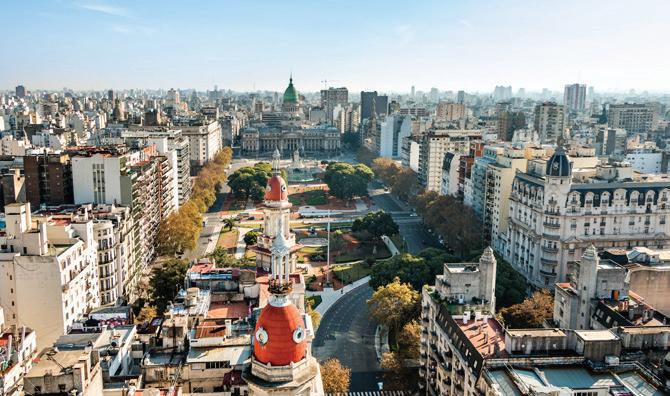
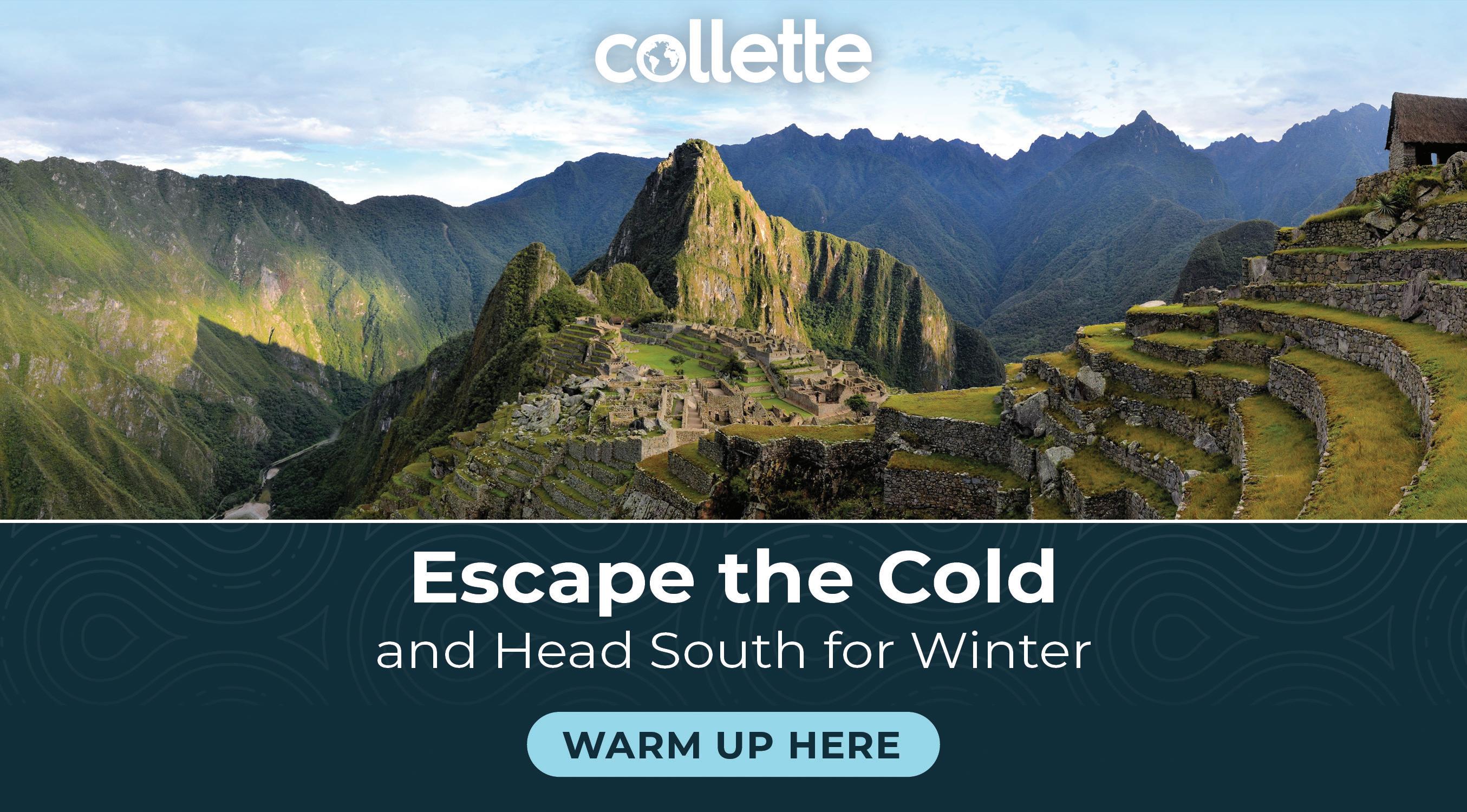

WELLNESS EXPERIENCES | EPIC ARGENTINA | CRUISING THE WORLD’S RIVERS





WELLNESS EXPERIENCES | EPIC ARGENTINA | CRUISING THE WORLD’S RIVERS


With the Chesapeake Bay and Atlantic Ocean as its backyard, Virginia Beach is a favorite destination for groups looking to share experiences within a vibrant coastal community. Beautiful beaches, inland waterways and nature parks offer outdoor adventures from hiking to kayaking, while attractions like the Virginia Aquarium & Marine Science Center and the Military Aviation Museum provide opportunities for learning.
A thriving arts and entertainment scene as well as culinary specialties that showcase fresh, locally sourced seafood and produce add to the charm of Virginia Beach, where memorable moments can happen during a sunset cruise, along the Boardwalk or simply gathering around the table. In Virginia Beach, you’ll find everything you need for an adventure filled with laughter, learning and lasting memories.


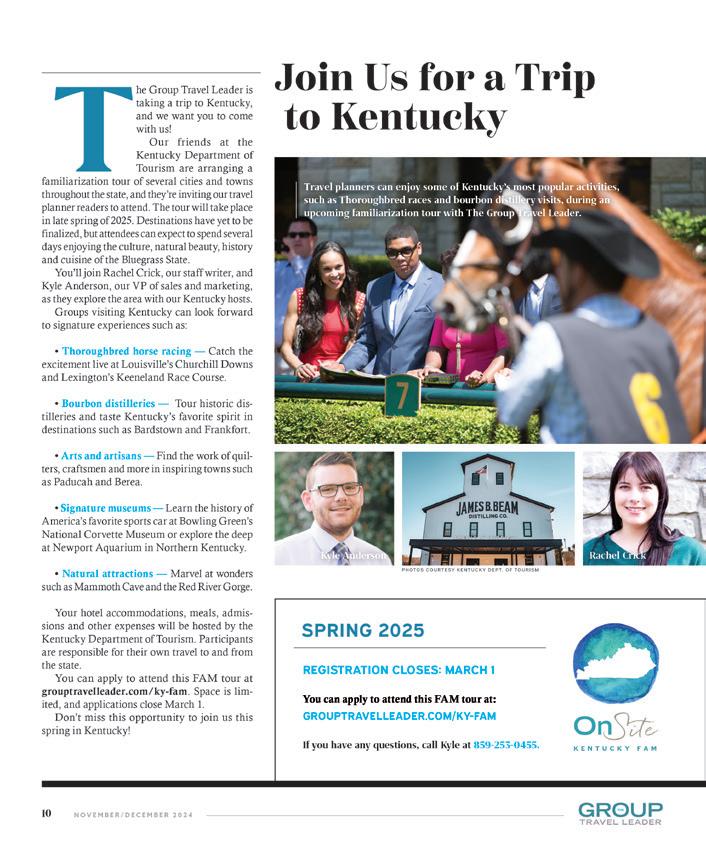
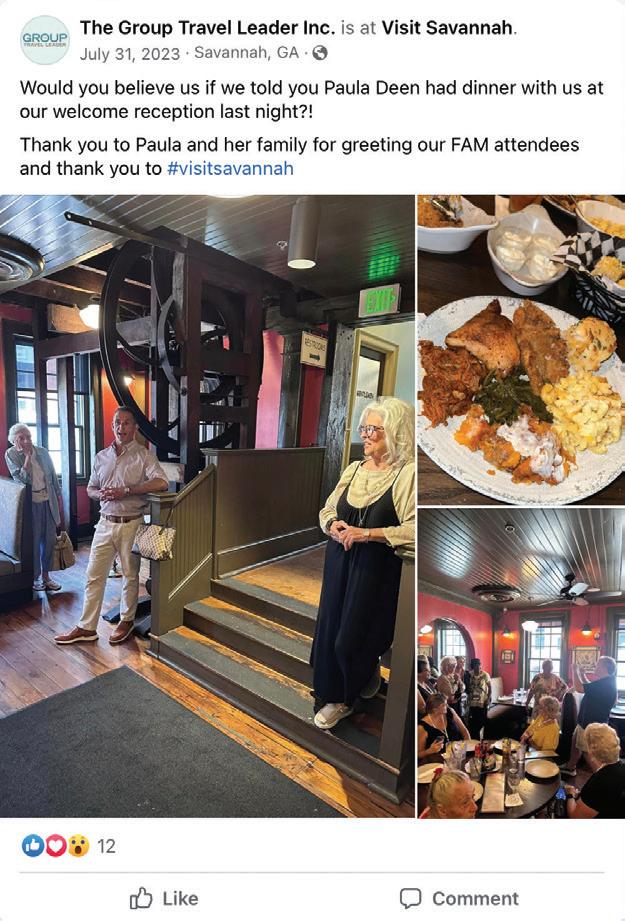
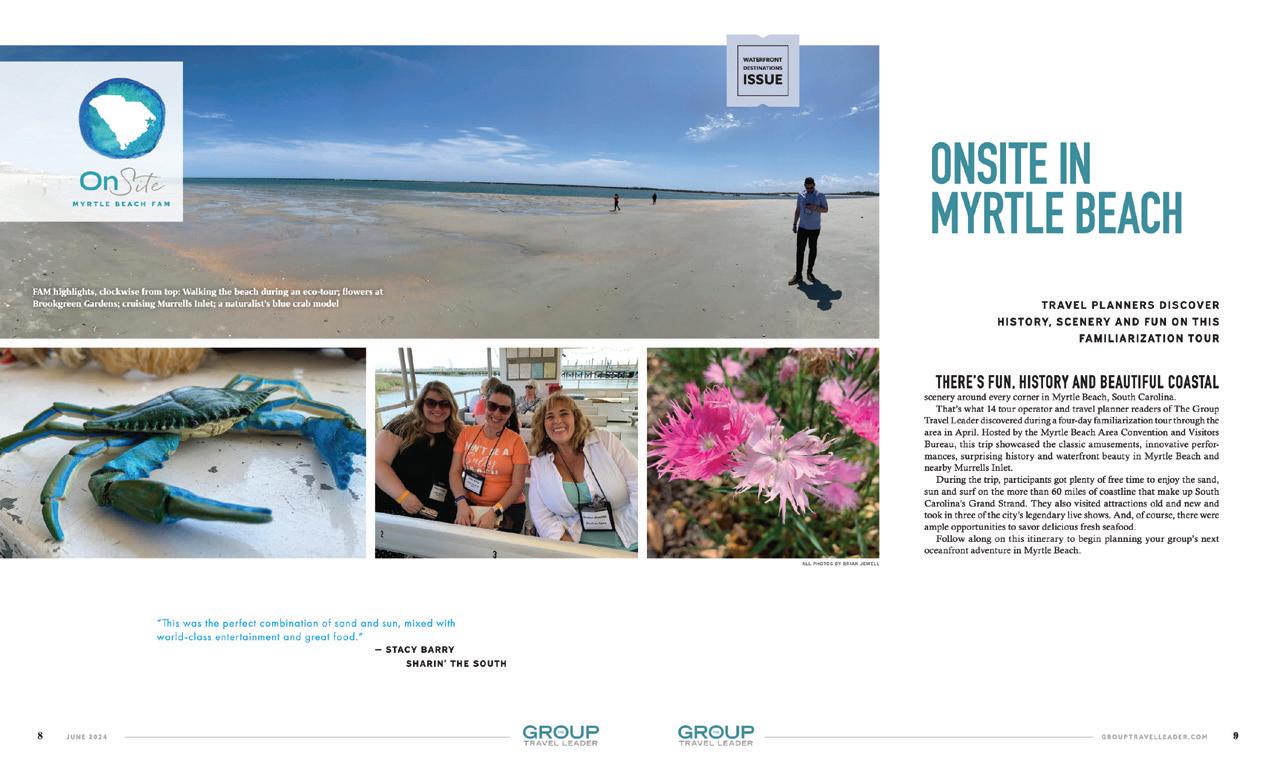












Are you looking for new ideas in your old favorites or a new destination for your group to enjoy?
Register for one of our FAMs to learn about these great destinations from the local experts.
FAMs are open to tour operators and group leaders with active travel clubs. Participants are responsible for their own travel to and from the destination. All other expenses including hotel accommodations, meals and admissions will be covered by our CVB hosts.






If you’ve never been to Owensboro, Kentucky, you’re in for a treat. The 2025 Select Traveler Conference takes place there March 9-11. Owensboro hugs the Ohio River in southwestern Kentucky and has become recognized internationally for its culinary and music traditions.
Although it is not as large as barbecue capitals like Kansas City, Missouri, and Memphis, Tennessee, Owensboro’s mastery of the barbecue pit has led to a worldwide following. Each May for more than 45 years, the city has hosted its International Bar-B-Q Festival, and many of the fest’s best barbecue-smoking teams are from local churches.
Select Traveler delegates will undoubtedly have the privilege of having a taste of smoked meats prepared by local experts.
Owensboro is also a good place to learn about Kentucky’s impact on music worldwide. The father of Bluegrass, Bill Monroe, first played what became known as Bluegrass music near Owensboro 70 years ago. He drew on much earlier music traditions that originated
in Ireland and Scotland and described the essence of Bluegrass as a “high lonesome sound.” Visitors can learn more about Bluegrass music and its influence at Owensboro’s Bluegrass Music Hall of Fame and Museum, downtown near Smothers Park on the Ohio River.
Because of its impact on music, Owensboro hosts many music events throughout the year. I have attended ROMP Music Festival, an outdoor music weekend held each June just outside town. ROMP features bluegrass and other music genres and has a loyal following. Select Traveler delegates will get to hear great music in Owensboro, probably more than once.
Smothers Park is just piece of a multimillion-dollar development on Owensboro’s riverfront. Over the past couple of decades, the city has capitalized on its riverside location, adding the Owensboro Convention Center, two adjacent hotels, elaborate playgrounds and fountains, and public art.
Make plans to join us next March in Owensboro. You’ll be glad you did.
Register for the 2025 Select Traveler Conference at selecttravelerconf.com.
Mac Lacy — Publisher
Email me anytime with your thoughts at maclacy@grouptravelleader.com.
BY BRIAN JEWELL
Sometimes small touches can make big impressions.
When people come on one of your trips, there’s little question that the destination should take center stage. But the activities and amenities you include along the way can help shape how people perceive the travel experience and, by extension, how they perceive your organization. And since the purpose of your travel program is to build affinity among your members, that perception is especially important.
If you want to make your travelers feel extra special, here are some amenities and inclusions to consider. Some can be implemented for very little cost.
Every traveler knows the deep satisfaction of taking a drink of cold water on a hot day or indulging in a sweet mid-day treat. Your travelers can certainly find those things along the way, but they will appreciate you making it easier for them. Work with your transportation company to have a cooler or two stocked with water and soft drinks and bring along a basket of packaged goodies to pass around. These treats feel like little luxuries but aren’t expensive — even for a large group, they’re not likely to cost more than $30 per day.
Nothing makes group travelers feel more significant than face time with important people. Tap into this potential by arranging meet-andgreet sessions with notable folks in the places you’re visiting: performers in a show, athletes or coaches at a sporting event, or city leaders or dignitaries. You might be surprised how easy it is to get VIPs to come say hello to your group — often, all you have to do is ask.
People who take a lot of group trips know that buffets and limited-selection meals are staples of the tour experience. This dining approach has advantages, of course, but also drawbacks. For a memorable impression, take your travelers to a great restaurant at least once during a trip and let them order whatever they want. Budget for one appetizer, one entree and one dessert per person. The tab will likely come in under your projections. And don’t worry, it’s ok to ask people to pay for their own drinks from the bar.
Luxury hotels figured out decades ago that leaving a chocolate on a guest’s pillow increases perceived value. Leverage this strategy to impress your customers by working with your hotel partners to arrange a turn-down gift once or twice during the trip. These small gifts can range from candy made by a local chocolatier to souvenirs that will remind them of the trip after they return home. If you go this route, be sure to budget for the hotel’s delivery fee, which often ranges from $5 to $10 per room, in addition to the cost of the gifts.
Smart marketers have long known that people love swag — branded goods that companies hand out free. So offer some nice, thoughtful items to people who take your trips. To make the best impression, avoid cheap promotional merchandise and opt for quality items that could come in handy for travelers, perhaps a sweatshirt, a hat, a reusable water bottle or a passport wallet, all of which can be customized with your logo. People will love these freebies and continue to use them after the trip ends, which increases your organization’s brand awareness.




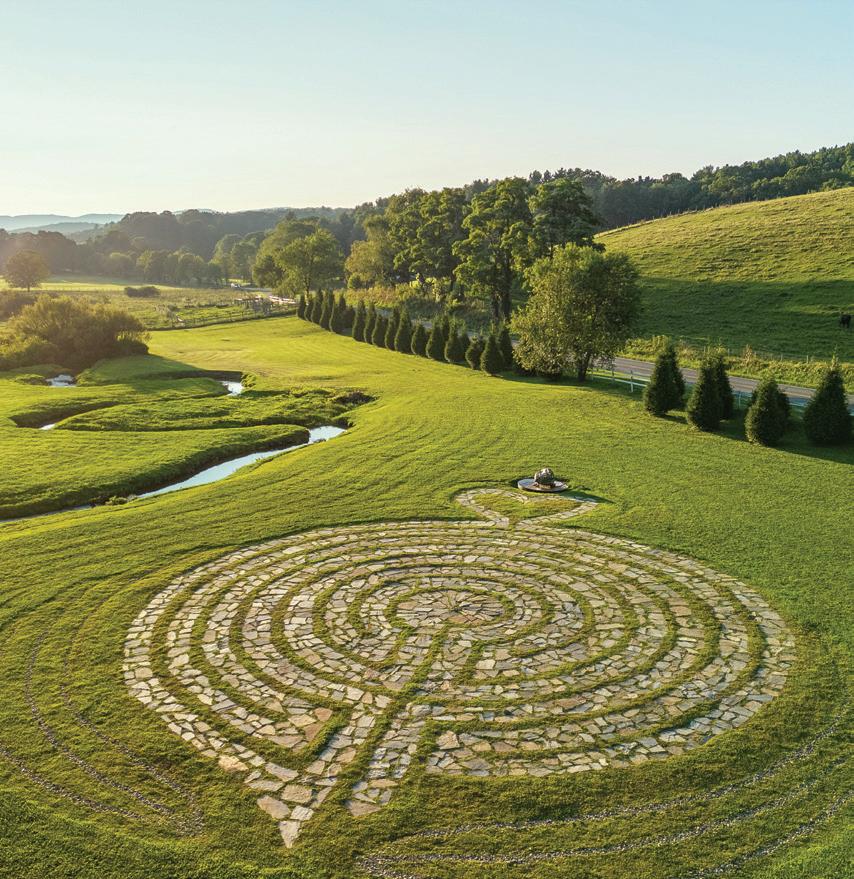
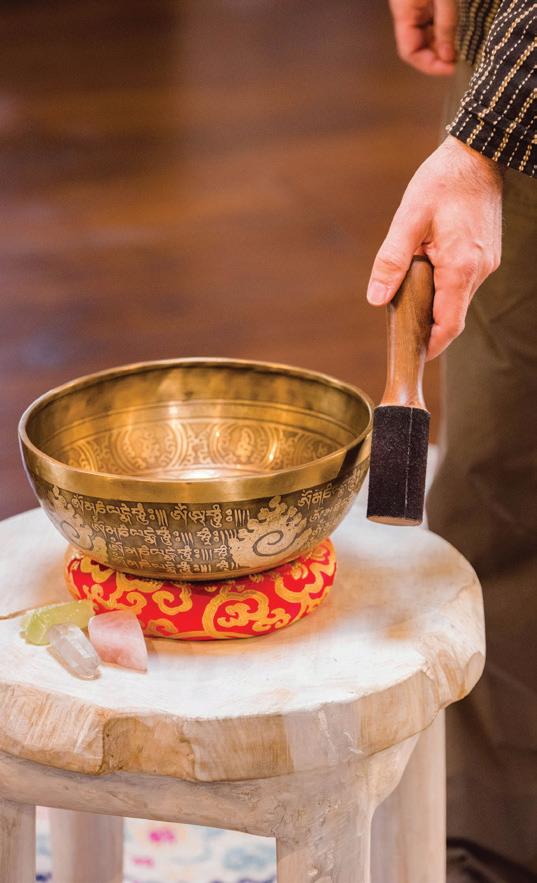
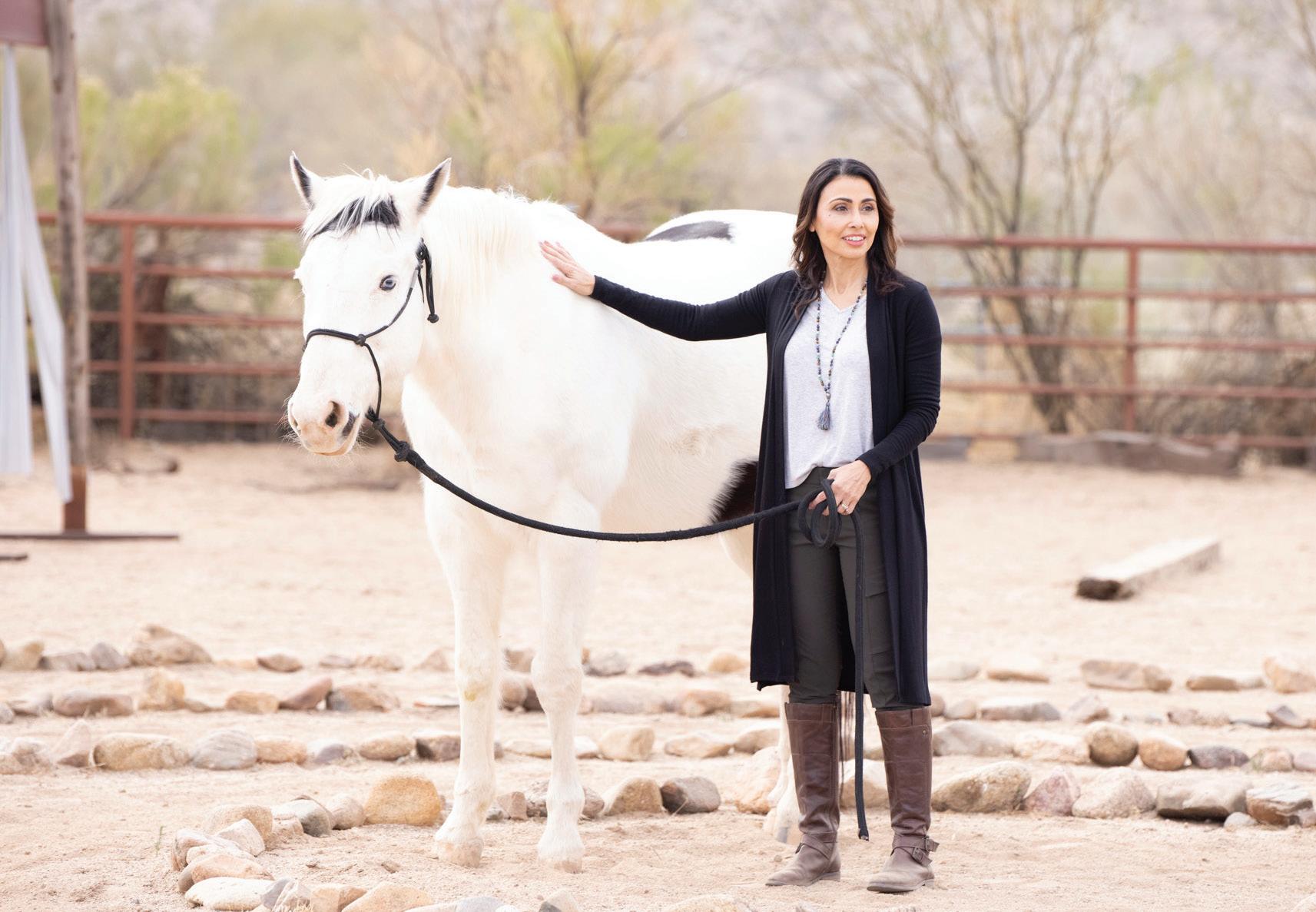
BY DIANA BOCCO
Imagine stepping into a place where stress melts away and the only thing on your to-do list is to unwind. Picture a getaway where every moment invites you to breathe deeper, move more freely and connect not just with yourself, but with the people you are traveling with.
No matter the setting — be it the tranquility of the desert, the peacefulness of mountain peaks or
the seclusion of thick forests — there’s a wellness escape that suits your group’s needs. From luxurious spa treatments to mindfulness retreats, these experiences deliver a perfect mix of relaxation and rejuvenation.
Here are six standout destinations where group travelers can explore transformative wellness experiences together.
Type of getaway: Holistic Wellness
Canyon Ranch, a resort brand with locations in Massachusetts, Arizona, Nevada, California and a soon-to-open property in Austin, Texas, offers an immersive wellness experience that combines luxury with holistic health. Known for stunning locations and sprawling properties, these resorts help groups focus on body, mind and spirit through a number of customizable packages. The experience includes spa treatments, fitness classes, and sessions with nutritionists and life coaches.
“Overall, I’d say we want groups to try something that they can’t do anywhere else when they come here,” said Katrina Palanca, Canyon Ranch’s senior vice president of brand growth. “Groups tend to play it safe with things they know — hikes, cooking classes and dinners — and there’s nothing wrong with that. But Canyon Ranch is the place to try something new. We have more than 100 trained and licensed Canyon Ranch experts on staff. Groups should take advantage of the expertise at their fingertips.”
Popular activities include group hikes (at the Tucson location, there are special “poetry and hiking” events), tennis and pickleball clinics with certified instructors, Ai Chi, desert drumming circles, and private dinners and cooking classes, including a group cook-off.
“Our demonstration chef will provide you with everything you need as you race against the clock to prepare the best meal in your group,” said Palanca. “The chef will then taste test each dish and announce the winner at the end.”
Palanca also recommends the “Boosting Your Brain Power” sessions.
“A Canyon Ranch integrative medicine expert will show you how to enhance your memory, creativity and problem-solving abilities and boost your brain power,” she said.
At the end of the day, guests can relax in the modern, airy rooms designed to support both privacy and connection — surrounded by nature with plenty of space to unwind.
canyonranch.com
Type of getaway: Mindfulness and Balance
Set in the desert of Tucson, Arizona, Miraval Resort and Spa has a laid-back, serene atmosphere that promotes relaxation and self-discovery. Miraval focuses on promoting mental well-being and self-care through experiences designed to help guests gain self-awareness, build confidence and tackle personal challenges.
Group programming at Miraval ranges from outdoor adventures like hiking and horseback riding to spa treatments and wellness workshops that focus on mindfulness. Group favorites offered as rotating activities include equine experiences, painting workshops, and culinary, nutrition, and cultivation sessions.
Specific programming highlights include a Quantum Leap trust exercise where guests expand their trust and comfort zones; a Just Let It Go improv class that aims to bring people together in a positive, collaborative space; or a Wine and Your Sign astrology session that allows you to understand your group on a cosmic level. A resident beekeeper will also lead immersive experiences in beekeeping for those interested.Miraval’s Tucson resort has designed its rooms, suites and private villas to be serene and luxurious with natural materials, soft tones and open views of the Sonoran Desert. miravalresorts.com
“Groups particularly enjoy the labyrinth and bonfire area, which are ideal for reflection and bonding.”
— DAVE HALL, THE ART OF LIVING RETREAT CENTER

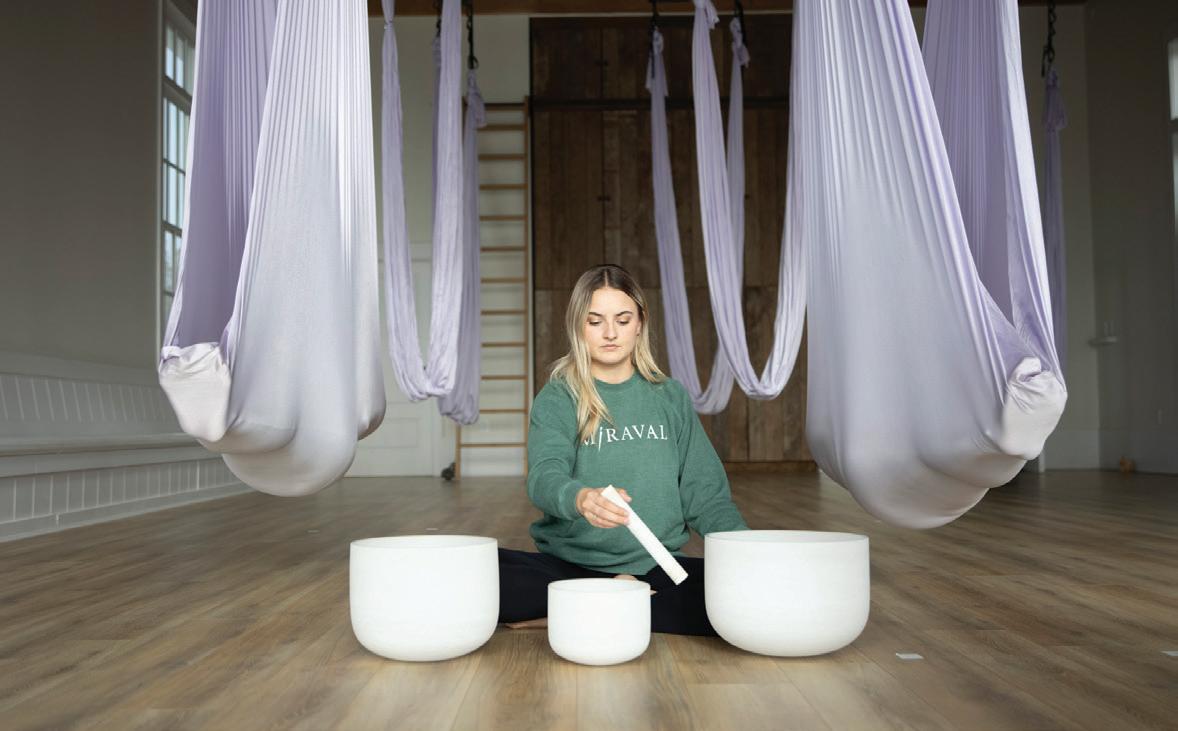

Type of getaway: Adventure and Wellness Retreats
Amangiri is where adventure meets luxury in a truly breathtaking desert setting. Located in the heart of Utah’s Canyon Country, this ultra-luxury resort blends the thrill of outdoor activities with a focus on wellness.
Amangiri specializes in experiences that connect guests with both the land and local culture. Groups can indulge in open-air yoga sessions, sound healing, guided meditation and dreamcatcher-making sessions. For more active pursuits, there are guided hikes to view ancient petroglyphs and learn about the Navajo heritage; horseback rides through the desert; via ferrata climbs, which entail scaling canyon walls on fixed cables and ladders; and stargazing sessions guided by expert astronomers.
Amangiri offers two types of luxurious accommodations perfect for groups. The spacious and minimally elegant suites have floor-to-ceiling windows with stunning desert views and private terraces. For a more immersive experience, tented pavilions bring guests even closer to nature, blending comfort and adventure. Pavilions give guests the feeling of camping under the stars while providing highend amenities like private plunge pools. aman.com/resorts/amangiri

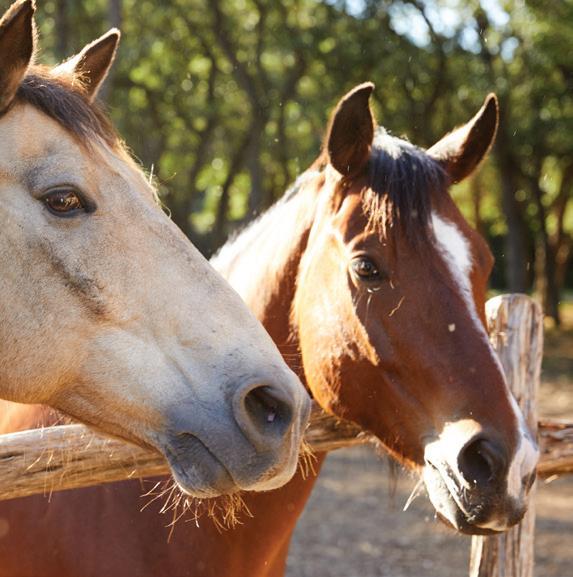

Dining among the rocks at Amangiri

Type of getaway: Ayurveda and Meditation Retreat
Perched high in the Blue Ridge Mountains, the Art of Living Retreat Center is a sanctuary for group travelers who seek a deeper connection through yoga, meditation and Ayurveda (a holistic healing philosophy). This center creates immersive experiences that allow guests to unwind, breathe and center themselves in an environment that feels miles away from the hustle of everyday life.
A variety of group programs suit different wellness needs.
“Popular options include daily yoga and meditation sessions, Ayurvedic workshops and guided nature hikes through the center’s scenic trails,” said Dave Hall, director of marketing at the retreat center. “Groups particularly enjoy the labyrinth and bonfire area, which are ideal for reflection and bonding.”
Hall added that groups love the Ayurveda Wellness Escape, which offers personalized consultations, workshops and treatments.
“As the day winds down, groups in particular often love to gather around the bonfire to relax, share stories and reflect on the transformative experiences they’ve enjoyed,” he said.
Set on 380 acres with mountain views and tranquil grounds, accommodations at the Art of Living Retreat Center promote relaxation and personal growth. Premium hotel rooms have stunning views and modern hotel amenities; fully furnished apartments include a kitchenette and balcony.
artoflivingretreatcenter.org
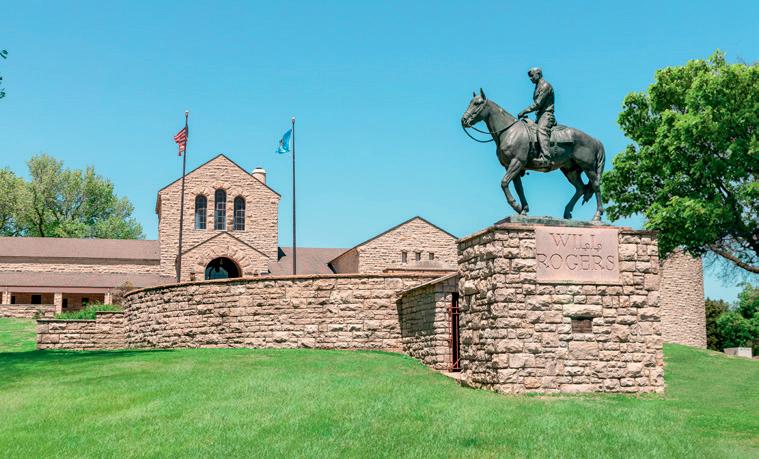



Type of getaway: Detox and Regenerative Wellness
Eupepsia Wellness Resort, in the heart of Virginia’s Blue Ridge Mountains, offers a transformative detox and wellness experience that combines modern science and traditional therapies. What sets Eupepsia apart is its focus on regenerative wellness, incorporating farm-to-table nutrition, Ayurvedic therapies and personalized wellness programs that address each guest’s specific health goals. Recently named a top U.S. wellness retreat by the USA Today Readers’ Choice Awards, Eupepsia has expanded its offerings to include immersive agritourism programs so guests can experience regenerative farming firsthand. Groups will appreciate the varied activities, from guided hikes on the resort’s 256-acre property to yoga and meditation in serene natural settings. The resort’s wellness farm, with greenhouses, aeroponic towers and a micro-dairy, provides fresh ingredients for plant-based meals. Guests can tend the livestock or sample the resort’s artisanal chocolate, made from non-GMO cacao beans.
Accommodations at Eupepsia are designed for comfort and tranquility with rooms that are cozy yet modern and look out on the rolling hills and pristine farmland. This peaceful environment, combined with the resort’s focus on personalized wellness, makes it an ideal spot for groups looking to detox, recharge and reconnect. eupepsia.com
Type of getaway: Forest Bathing and Luxury Wellness
In the Hamptons, Shou Sugi Ban House is a luxurious wellness retreat center focused on peace and balance. One of the resort’s more unusual experiences, forest bathing,

BY FREDRIKA

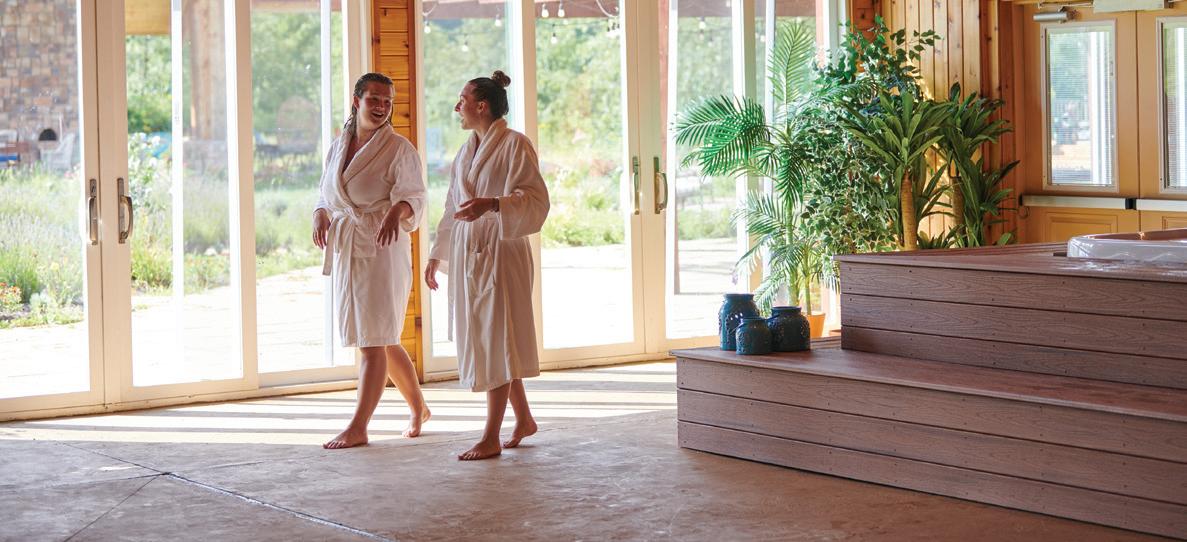
is a chance for groups to join guided sessions that connect them deeply with nature and are a perfect antidote to city life.
Shou Sugi Ban House’s array of wellness programs nurture both body and mind. Guests can try hydrotherapy in the plunge pools, practice daily movement with group yoga sessions or experience transformative healing through vibrational sound and reiki. Skin and body care are emphasized with tailored facials, massages, access to a eucalyptus steam room, custom workouts and body treatments using organic, natural ingredients. Those who seek deeper spiritual rejuvenation might try floating meditation in aerial silk hammocks or guided breathwork. The property’s minimalist, Japanese-inspired design creates a calming atmosphere that enhances the sense of escape. For accommodations, groups can choose from The Studios — individual, minimalist rooms with private gardens and indoor/outdoor rain showers — or the Private Residence, which offers open living spaces and a private pool and is ideal for groups seeking privacy and luxury. shousugibanhouse.com



Those

































































































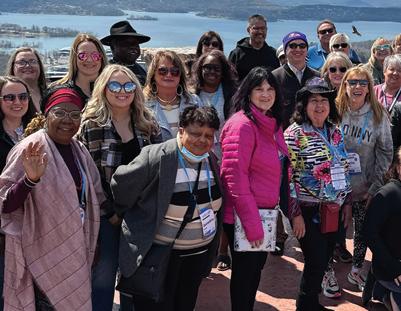







































































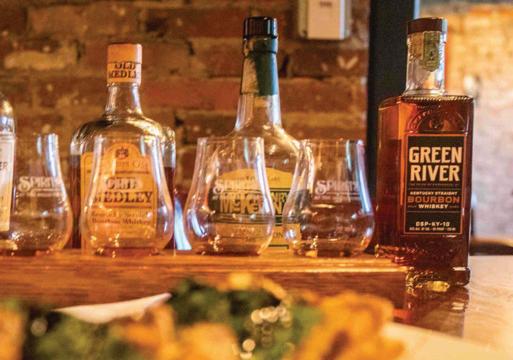



























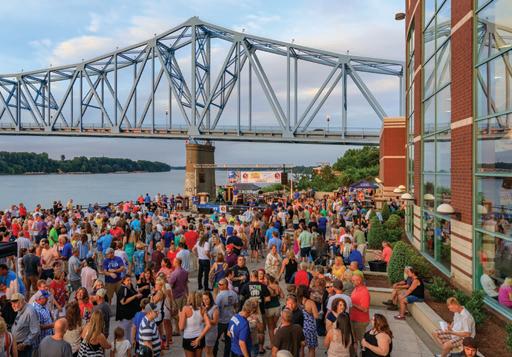

























































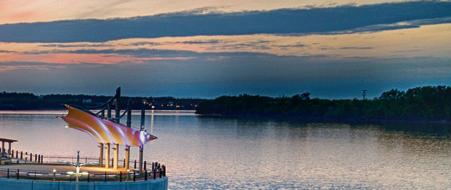

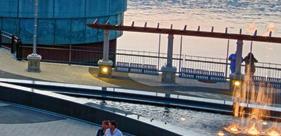






















BY CYNTHIA BARNES
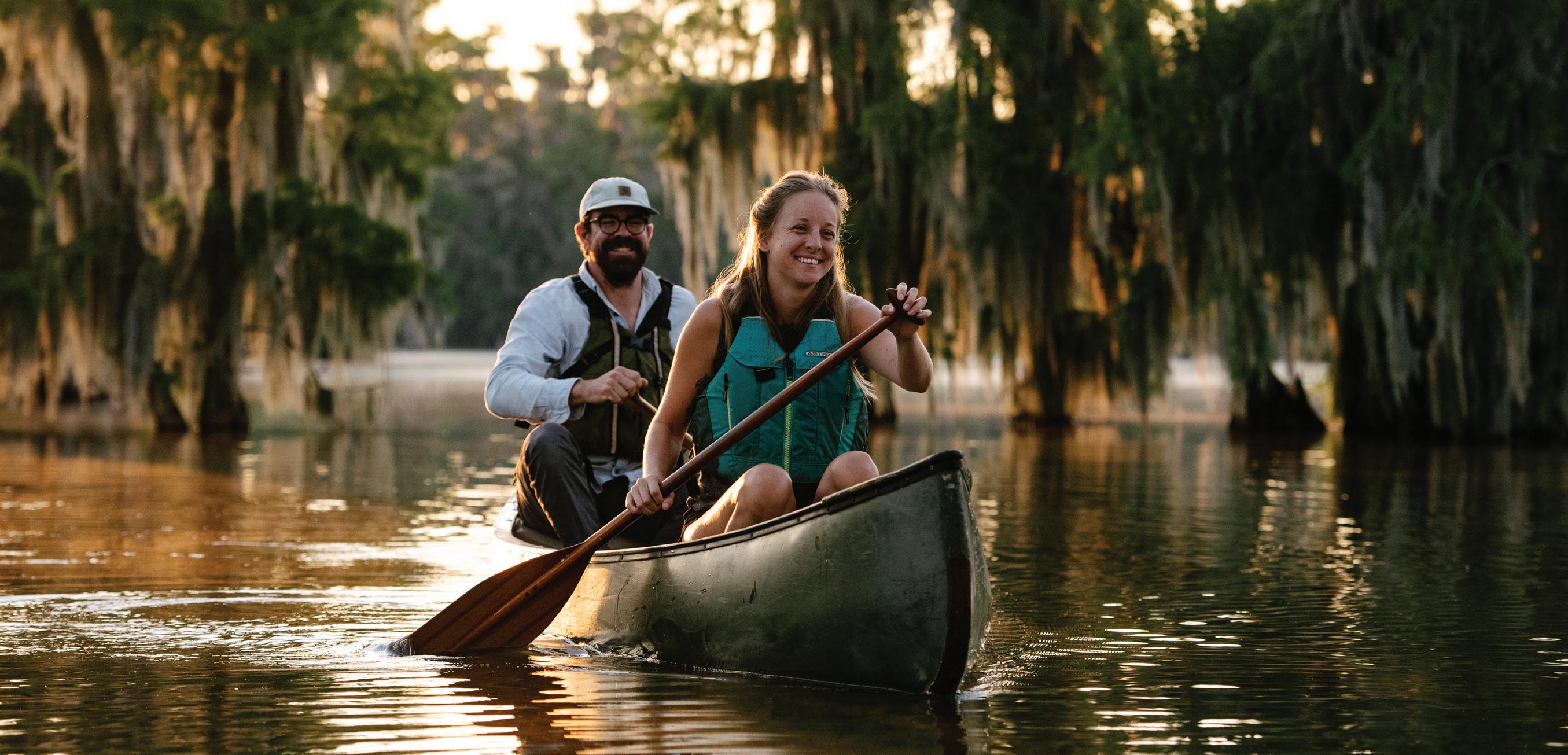
Travelers can enjoy stunning bayou excursions on Lake Martin near Lafayette.
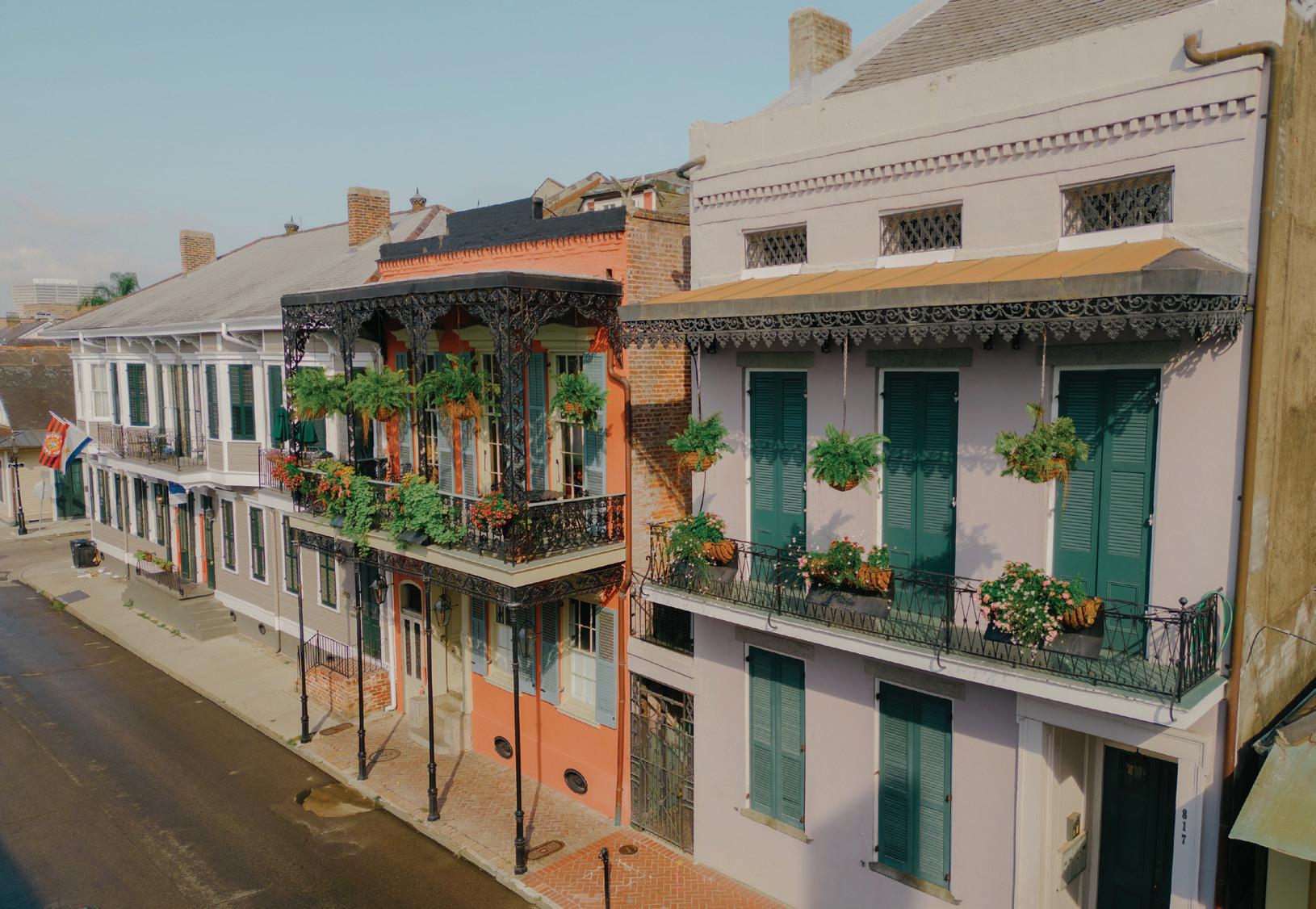
From bayous to Bourbon Street, there’s no place like southern Louisiana. The region’s diverse blend of cultures — French, African American and Italian are only the beginning —make for a setting that’s as complex as a rich bowl of gumbo and every bit as satisfying.
A soulful place, southern Louisiana’s byways and boulevards bear the traces of wars and weather, turmoil and tragedy. But its people have never lost the joyful spirit that sustains them in good times and bad, and visitors can share in the life-affirming culture evident in its architecture, tasted in its incomparable cuisine and heard in its lively music.
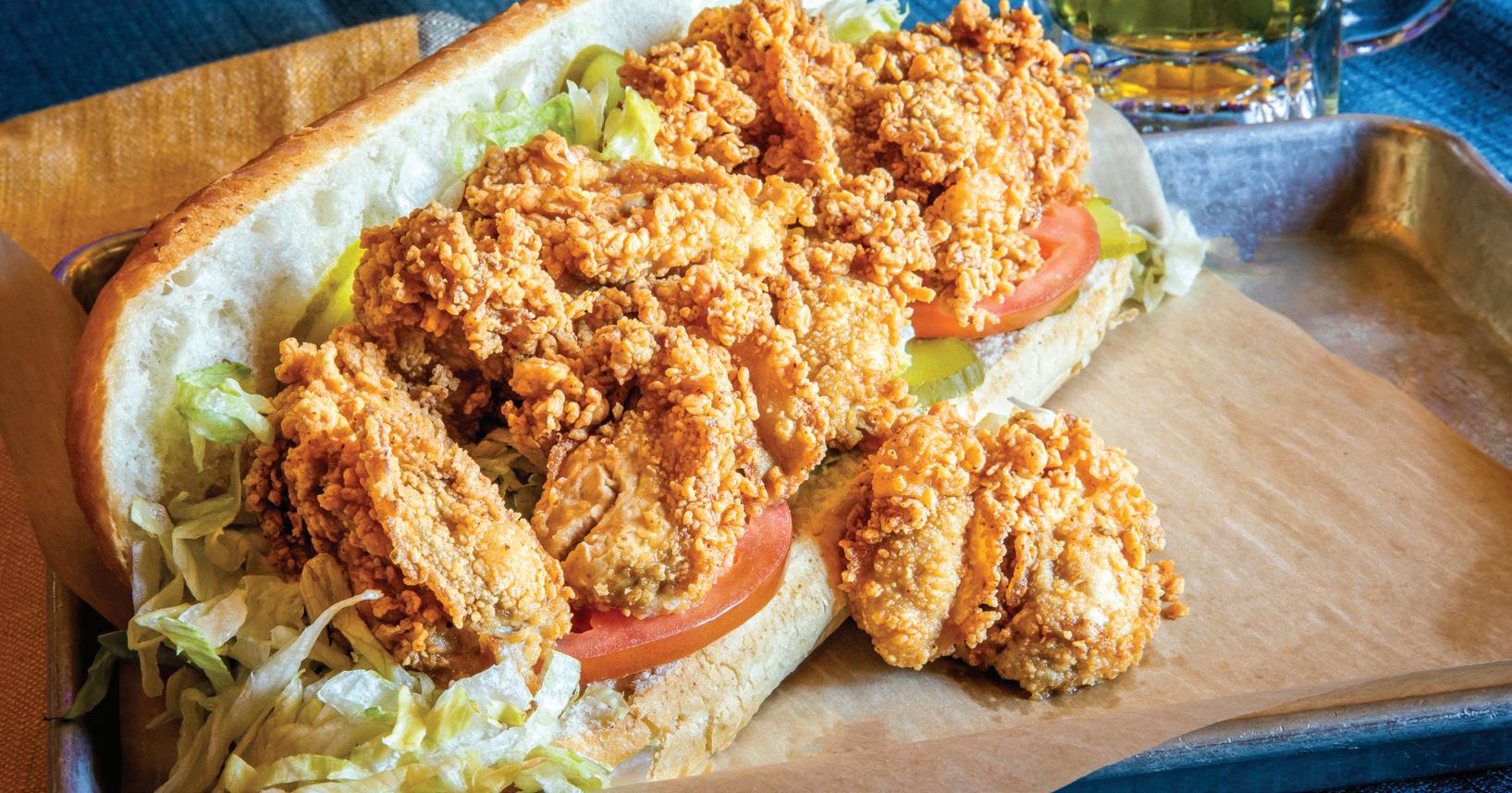
Native Americans have lived in the southern part of what is now Louisiana for at least 11,000 years, hunting among dense stands of hardwood forest and harvesting the bounty of its meandering waterways and the Gulf of Mexico. Spanish explorer Alonso Alvarez de Piñeda mapped the coastline in 1519. But it was the French who claimed the territory and established the first settlements in the early 1700s. They brought enslaved Africans, some of whom escaped with the help of local Indian tribes and formed their own independent settlements in the bayous and woods. Subsequent waves of immigrants staked their claims, and today this region is a true melting pot with residents whose roots stretch around the globe.
A tour of southern Louisiana guarantees a trip filled with memorable experiences and meals. Summers can be steamy, but the climate is generally temperate throughout the year, with festivals, events and celebrations in any season.
The best-known city in the Bayou State, New Orleans is located about 100 miles north of where the Mississippi River empties into the Gulf of Mexico. The original town, the Vieux Carré (Old Quarter), was established in 1718 on a sharp bend in the Mississippi, giving rise to one of New Orleans’ nicknames, “the Crescent City.”
The river is the heart of New Orleans, and there’s no better way to experience it than on a cruise aboard a steam-powered paddleboat. The Steamboat Natchez has three decks and a variety of sightseeing cruises, which can be enhanced with food and cocktails, all accompanied by


jazz (New Orleans is the birthplace of the genre). Group discounts and private VIP events are available. To start the cruise in style, arrange a second line parade to accompany your group to the wharf. A New Orleans tradition, these joyful processions feature brass bands, dancing and colorful costumes.
New Orleans became the home of the cocktail when Antoine Peychaud stirred up the Sazerac in 1832 at his apothecary on Royal Street. That location now houses a coin store, but you can learn more about cocktails at the Southern Food and Beverage Museum, which is home to the Museum of the American Cocktail. The museum also includes the Deelightful Roux School of Cooking, where groups can take a hands-on cooking class and then enjoy the delicious results. The venue is available for private events for groups of 20 to 400.
For an experience that’s truly local, veteran journalist Barry Yeoman recommends catching some music at Bullet’s Sports Bar in the Seventh Ward’s Treme neighborhood.
“It’s a fun off-the-beaten-track place,” said Yeoman, “Black-owned, and one of the last ‘back o’ town’ neighborhood bars. One group that plays there a lot is The Original Pinettes Brass Band, which is — as far as I know — the only all-women
brass band in New Orleans. And a great place for lunch is the Parkway Bakery and Tavern, which has, in my mind, the best po’boys in town.”
neworleans.com
The state capital, Baton Rouge, is a city with a long history. Two earthen mounds on the LSU campus date back 11,000 years, making them the oldest human-made structures in the Americas. The Old Louisiana Governor’s Mansion is now an elegant museum, with guided tours available. Built by legendary governor Huey P. Long in 1930, “Louisiana’s White House” and its rose garden sit on a live oak-lined boulevard downtown.
Josie Evans, vice president of marketing for the Louisiana Travel Association, says people should not miss the Old State Capitol and the Capitol Park Museum.
“You can book a private tour and it showcases the history of Louisiana, from pre-Colonial times to modern day,” she said. “It’s got a lot of interactive exhibits and covers everything from the state’s musical heritage to its politics.”
She also touts the capital’s food and brewery tours. “We have a growing craft brewery scene. There are places like Tin Roof Brewing and Rally Cap Brewing, with

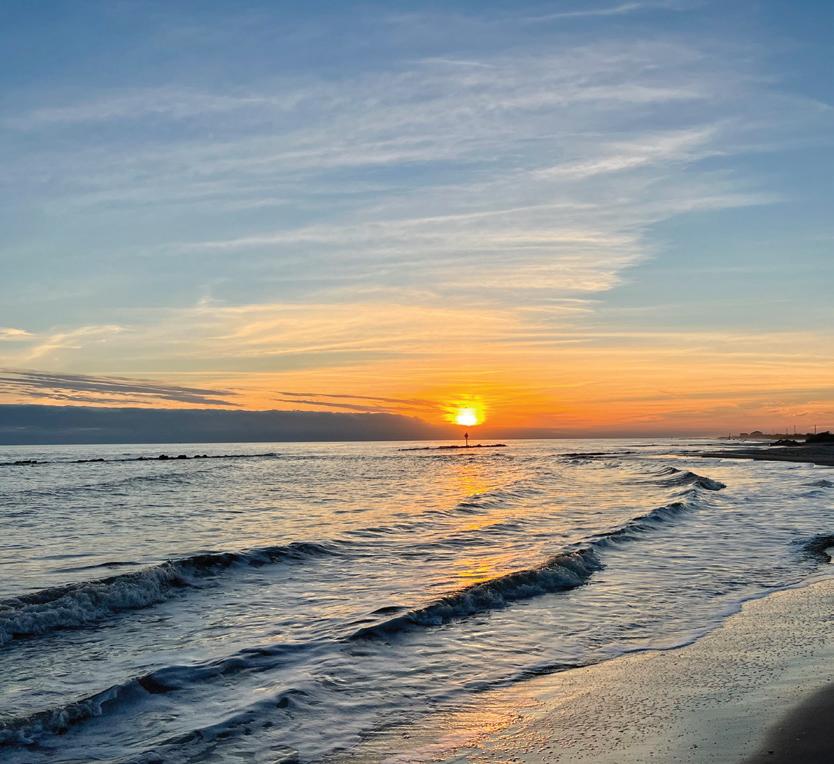


“It’s a fun off-the-beaten-track place, Black-owned, and one of the last ‘back o’ town’ neighborhood bars.”
— BARRY YEOMAN, JOURNALIST
all different kinds of craft beer, and you can get local cuisine paired with it as well.”
A vibrant arts and cultural scene is evident in abundant galleries, the Shaw Center for Arts, a contemporary visual and performing arts facility; the Manship Theatre; and the LSU Museum of Art and LSU School of Art Gallery. Souvenirs at the museum’s store highlight ceramics, paintings, jewelry, toys, stationery and more made by local talent.
visitbatonrouge.com
Lafayette is the epicenter of the state’s rich Cajun heritage and the largest Francophone community in the United States. When French-speaking Catholic
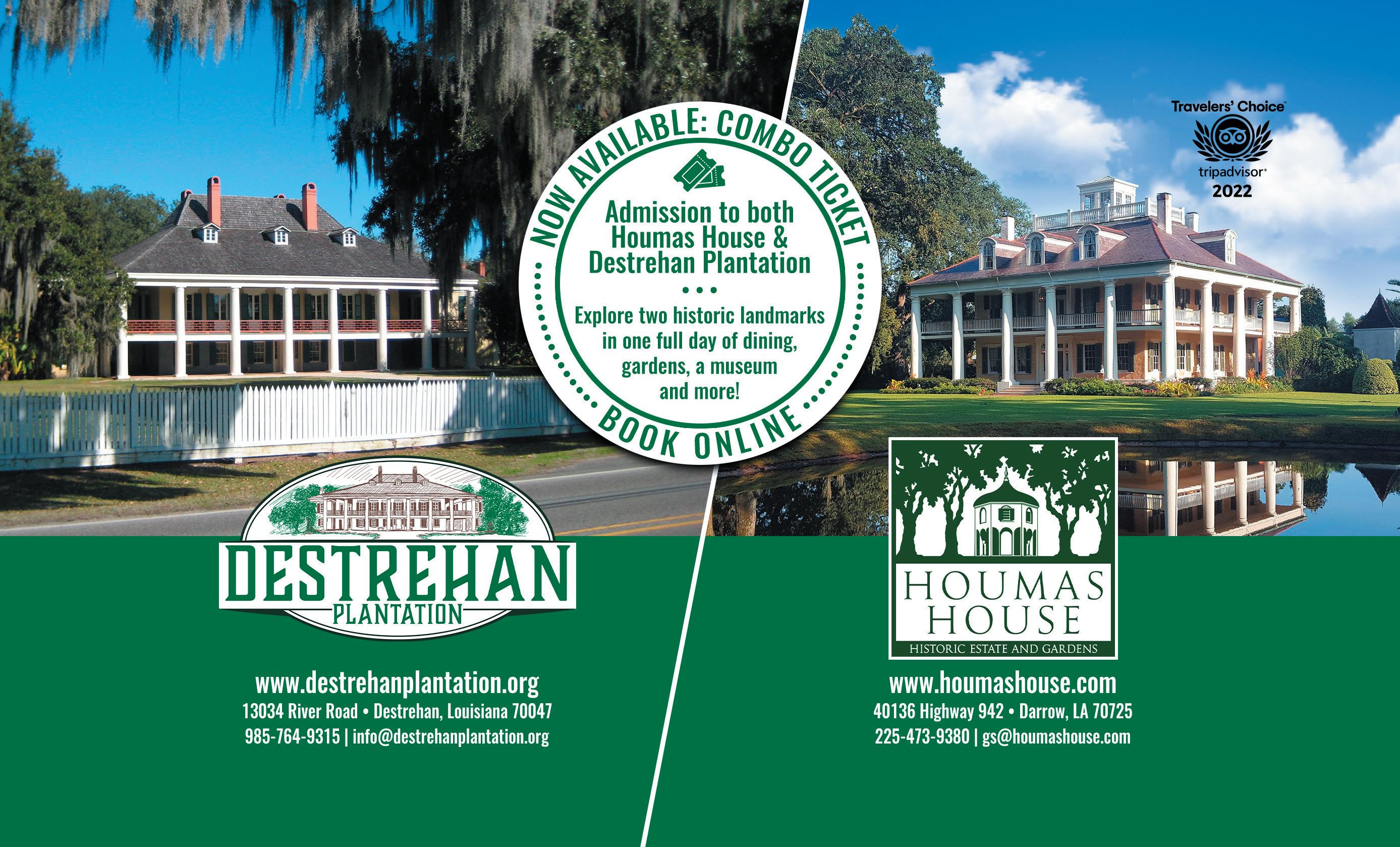
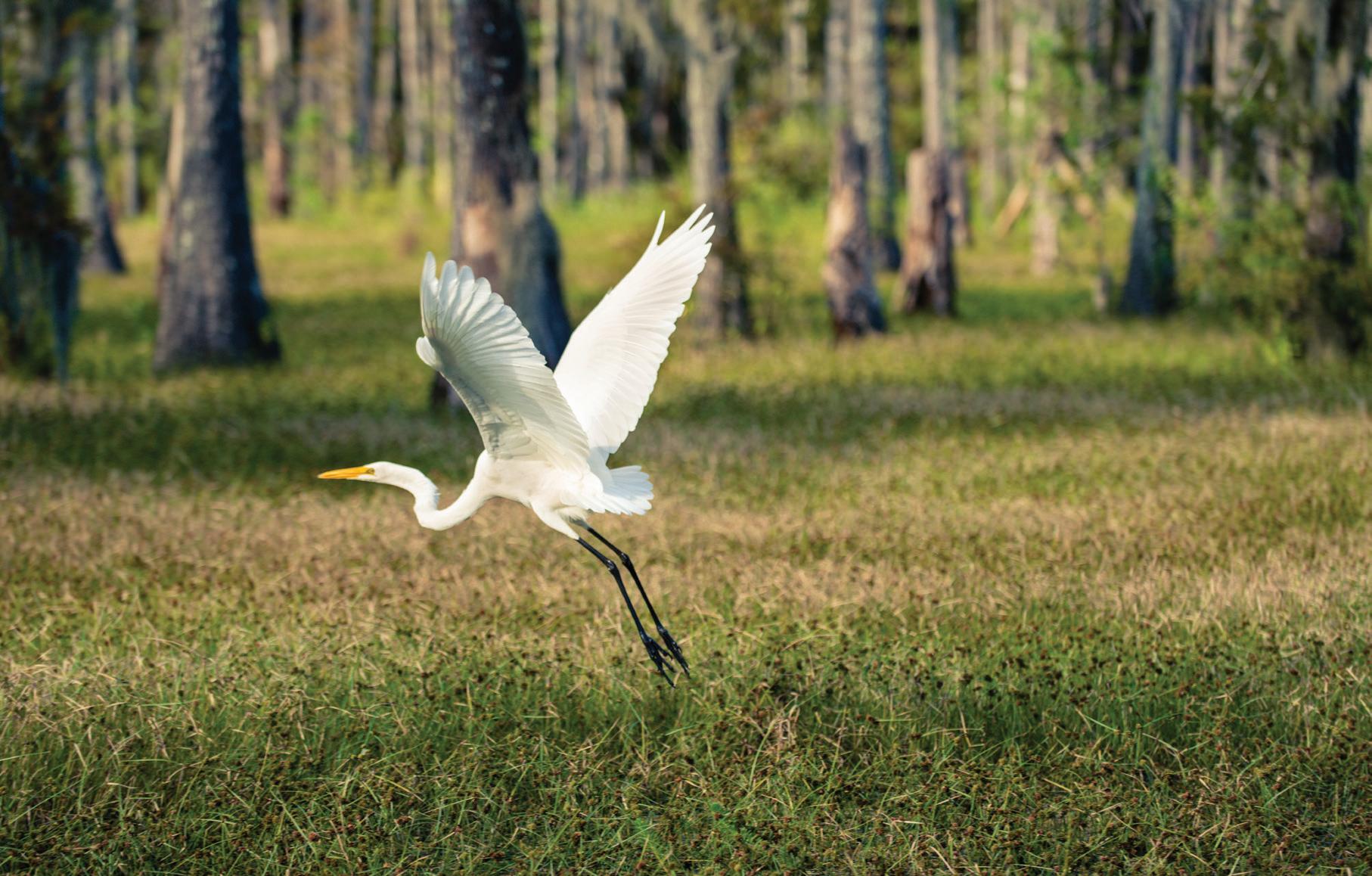
BY LINDSEY


inhabitants of Acadie (now Nova Scotia) were expelled by the British governor in 1755, many of the exiles found their way to New Orleans, then settled along the bayous west of the city where they practiced their own beliefs and customs and preserved their dialect and heritage.
That heritage is on display at Acadian Village, a reconstruction of earlier days where groups can tour historic cabins and structures and watch demonstrations of traditional arts, crafts and cooking. Groups will also want to tour the Lafayette Museum Historic Home and Gardens. Constructed around 1800 by Jean Mouton, one of the first settlers of southwest Louisiana, the original property was a one-room structure with a detached kitchen before it was expanded by Mouton’s son Alexandre, the state’s first Democratic governor.
Cajuns are famed for their food and their music, and no visit is complete without an evening at a traditional dance hall. Prejean’s and Randols, which have moved to the nearby town of Breaux Bridge serve authentic cuisine — don’t miss the etouffee — and live zydeco music. Zydeco blends French accordion music and Afro-Caribbean beats and will have your group two-stepping in no time.
A raucous evening of music can be followed by a peaceful morning paddle on Bayou Vermillion or along the Lafayette Parish Paddle Trail.
lafayettetravel.com
The bustling port city of Lake Charles combines Cajun culture with Texas swagger, and there’s plenty of natural beauty as lagniappe (“something extra”). Get back to nature along the Creole Nature Trail, where marshlands and estuaries teem with alligators and over 400 species of birds.
With 26 miles of Gulf of Mexico beaches and fishing areas “This is Louisiana’s outdoor playground,” said the Louisiana Travel Association’s Evans. “There’s so much to enjoy. Charter fishing trips take you out into the Gulf or any of the inland lakes so you can catch redfish, speckled trout or catfish. And there’s Sam Houston Jones State Park, with hiking, bird watching and picnicking, all in a serene, natural environment.”
Golfers and gamblers will be spoiled for choices, with four casinos and numerous public golf courses that are playable
year-round. Shoppers will head straight downtown, where they can select one-ofa-kind, handcrafted headgear at Bespoke Hat Company, where each hat is custom made to order. Visitors can take a piece of southwest Louisiana’s culture and cuisine home with locally produced Cajun goods including crafts, sauces and spices from Bux Kajun Korner.
Groups should be sure to sample the state’s signature sausage at the momand-pop food establishments, specialty meat shops and grocery stores along the Southwest Louisiana Boudin Trail. The traditional version of boudin incorporates cooked pork, chicken or pig’s liver, rice, bell pepper, celery, green onions, parsley and spices, but crawdad, catfish, shrimp and crab make a tasty seafood alternative. Treat the group to an elegant evening at the award-winning Pat’s of Henderson. Open since 1948, the restaurant’s stuffed red snapper and lobster bisque are local favorites.
Lake Charles has no shortage of nightlife, from nationally known touring performers at the area’s casinos to zydeco, country and rock at the Panorama Music House and other bars and clubs.
visitlakecharles.org


Each year, more than 30 million people visit the Crossroads of America, better known as Indianapolis. And it’s no wonder so many flock here — this capital city of nearly 880,000 blends Hoosier hospitality with all the hustle of a fast-moving metro.
From fantastic festivals to its famous motor speedway and medley of museums, Indy offers travelers an abundance of art and amusement. Its varied attractions appeal to groups of all ages, sizes and interests, so travel planners can pack their itineraries with a range of crowd-pleasers.
To get the most bang for their buck, travelers should invest in the Indy Attraction Pass, which lets them enjoy seven of the city’s top attractions for one discounted rate.
BY RACHEL CRICK
White River State Park spans 250 acres in Indianapolis’ downtown core, making it the largest urban state park in the country. With its greenspaces, public art and activities, it’s at the top of the list for visitors. It is also home to seven of the city’s attractions. Groups could easily explore the park for half a day or longer.
“We call it Indy’s backyard, and it’s great way to access the city’s attractions and museums,” said Clare Clark, senior communications manager at Visit Indy.
That list includes two of Indy’s top museums: the Indiana State Museum, which details the history of Indiana from prehistoric times to present day and includes an IMAX theater for educational and entertaining films, and the Eiteljorg Museum of American Indians and Western Art, with works by Andy Warhol and Georgia O’Keeffe, among others.
There’s also the Indianapolis Zoo, notable for its chimpanzee, orangutan, reptile and macaw habitats, as well as White River Gardens, a gorgeous botanical garden.
Sports lovers might want to visit the NCAA headquarters and its NCAA Hall of Champions, a museum celebrating greats in college sports with exhibits and memorabilia. Or they can watch a baseball game at the park’s Victory Field, home to the Indianapolis Indians.
The park’s 3-mile canal features stunning cityscape views, and cruising or paddling down the waterway is an option for groups. They can also walk along the park’s 8.1-mile Cultural Trail for a tour of the city and its large collection of public art and monuments. The trail will soon expand to 10 miles.
Indy is home to America’s largest single-day sporting event, the Indy 500, which draws 300,000 visitors to the Indianapolis Motor Speedway each Memorial Day weekend.
Even if groups can’t be in Indy for the big race, the Indianapolis Motor Speedway is a year-round attraction worth visiting, to see the Indianapolis Motor Speedway Museum and its collection of historic cars and racing memorabilia detailing the race’s 100-plus years of history.
The museum is slated to reopen in April following an $89 million renovation and expansion.
“Now when visitors come, they’ll be able to experience the history and environment that they would get as an attendee in the grandstands at the Indy 500,” Clark said. “There are interactive exhibits, expanded square footage, and more engaging displays and ways to properly display their thousands of artifacts.”
In the meantime, track tours are still available, depending on the track schedule and weather. Among the options is a tour that allows groups to ride around the track in their motorcoach. They end their ride with “kissing the bricks,” a tradition upheld by race winners.
Another campus that blooms with attractions is the Newfields, located on 152 acres just outside of the city. With an emphasis on art and nature, it’s a great stop for groups to spend an afternoon. It’s also included on the Indy Attraction Pass.
“The attractions at the Newfields are great for groups with


a more mobile and outdoor-focused itinerary,” Clark said.
The best-known attraction on the grounds is the Indianapolis Museum of Art, home to over 50,000 works, including the most comprehensive collection of Neo-Impressionist paintings on the continent. Visitors can admire works by artists such as Rembrandt and Picasso. An interactive exhibit, The LUME, displays works in digital gallery spaces to display art by Spanish painter Salvador Dalí.
The French-inspired Lilly House, a national historic landmark built by the Landon family, and its garden and greenhouse is also on the grounds.
In addition to greenspaces and gardens, other sights Newfields include the Virginia B. Fairbanks Art and Nature Park, with sculptures, a 35-acre lake, woodlands and a pollinator meadow. Groups can grab a bite or a pint at the Garden Terrace and Beer Garden at the Newfields, which offers light fare, beer and wine, and outdoor views.
Newfields is known for its seasonal activities, like harvest nights in the autumn months, complete with Jack-o-Lantern-lined trails, and brilliant light displays during the winter holidays.
Indy hosts a long list of festivals and events year-round, from celebrations of the seasons to exciting sports events.
In addition to the Indy 500 at the Indianapolis Motor Speedway, the city is home to other signature events like the Indiana State Fair, held over several weeks each summer. It highlights the state’s agricultural roots and features plenty of fair food, rides and entertainment.
Indy’s festival scene is great for art lovers. The country’s largest single-day arts fair, Penrod Arts Fair, is held annually at the Newfields on the Saturday after Labor Day. Another festival that’s making headlines is BUTTER, a multi-day fine art festival of works by Black visual artists. It’s held every Labor Day weekend and brands itself as a blueprint for equitable art festivals. More than 32,000 people have attended since its inaugural event.
“One hundred percent of the proceeds for the art that’s sold goes back into the pockets of the artists themselves, so we definitely take some stake in calling it ‘America’s Most Equitable Fine Art Fair,’” Clark said.
Festivals are a great way to sample local cuisine, and groups are guaranteed a gourmet experience with options like the Indiana Microbrewers Festival, Devour Indy (a twoweek food festival) and the Indiana Strawberry Festival.
Some of the city’s other top events are the IndyFringe Theater Festival and Gen Con, a four-day gaming festival complete with a massive block party.
BY JILL GLEESON
No matter the season, there’s always a reason for groups to visit southwestern Pennsylvania’s Laurel Highlands.
About an hour’s drive from Pittsburgh, the region offers a compact collection of some of the country’s most important historical landmarks, along with lesser-known attractions groups are sure to equally enjoy. And it’s all set within the spectacular Appalachian Mountains, making the Laurel Highlands an ideal destination year-round.
“It’s kind of a running joke that my favorite season in the Laurel Highlands is the next one,” said Eric Knopsnyder, director of public relations and community outreach for Go Laurel Highlands. “But we really do have so many things of historical value to this country and the world. And the great thing is, groups can see them in a short amount of time.”
From iconic showstoppers to exquisite hidden gems, here are four historic sites travel planners will want to include in any Laurel Highlands itinerary.
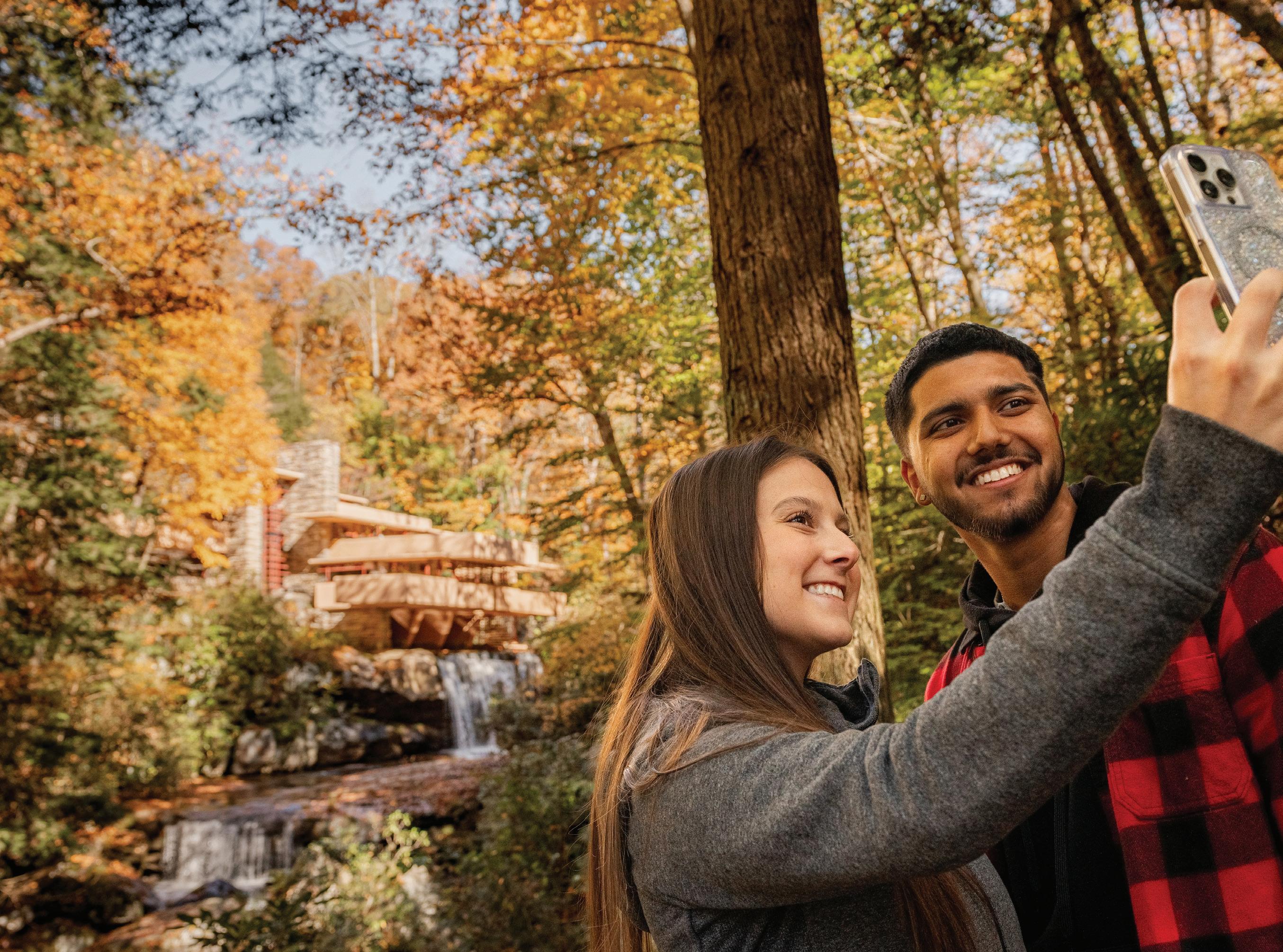
Located on the site where United Airlines Flight 93 crashed on September 11, 2001, the Flight 93 National Memorial pays tribute to the 40 Americans who heroically thwarted the hijackers’ plan to crash into on the U.S. Capitol. Rather than allow the plane to be used in the attacks, the passengers and crew of Flight 93 attempted to take back control of the aircraft, leading the hijackers to crash it. The 2,200-acre memorial’s visitor center has an interactive exhibit that describes the events of 9/11; the Wall of Names, 40 polished white stones inscribed with the names of those lost; and the 93-foot-tall Tower of Voices, from which ring 40 wind chimes.
The memorial is free and takes about three hours to experience fully. The site is managed by the National Park Service, and it doesn’t offer group tours, but rangers can provide an orientation if time allows.
“It’s something that I think every American should visit at least once,” Knopsnyder said. “The different aspects can be haunting, but it’s also empowering. You hear that Tower of Voices, and you realize what people did there and the sacrifices they made and the courage it took. It can really be an uplifting experience.”
Tucked away in the little town of Ligonier, so charming it would put any Hallmark movie location to shame, Fort Ligonier will delight anyone even slightly interested in America’s past.
“George Washington served there,” Knopsnyder said. “They have a great museum that has pistols he owned. The fort was the site of a battle on October 12, 1758, where the British were able to drive away a group of French and Native American forces. I’d set aside two hours to see the inside and tour the grounds. And then if you want to arrange for lunch in town and do some shopping, groups could easily spend half a day there.”
Fort Ligonier Days, a three-day festival held each October to commemorate the battle, is always fun and features reenactments, juried crafts, a parade and more. Or leaders can arrange a specialty tour of the fort. Options include a sunset outing with a wine reception and lantern-lit walk, and the popular “George Washington: Forts and Failures That Led to Success” tour. This experience is led by a reenactor who shares stories of the young Washington’s adventures and ends with visitors enjoying ice cream, Washington’s favorite treat.
Visionary American architect Frank Lloyd Wright’s masterwork, Fallingwater was designed 90 years ago as a vacation home for the Kaufman family, owners of a Pittsburgh department store. The iconic structure, named a UNESCO World Heritage Site in 2019, perches so daintily over a sweeping waterfall it appears to float there, seamlessly blending art and nature.
Private tours are available of the terraced home and the grounds, surrounded by 5,100 serene acres of mountain forest. Preordered boxed lunches can be enjoyed on site. Since it opened to the public in 1964, seven million people have visited Fallingwater. The experience changes
dramatically with the time of year, according to Knopsnyder.
“The beauty of the Laurel Highlands in the different seasons is really reflected in Fallingwater,” he said. “When you see it in the spring, or in the summer, it’s very different than when you see it in the fall with the foliage. There are limited hours in the winter, but if you get there on a December weekend and see it covered in snow that’s an incredible experience unto itself.”
Historic Hanna’s Town, an archaeological site and openair museum, was once a vibrant Colonial settlement on the wild and woolly western fringes of the frontier. As revolutionary fervor swept through what would become the United States, residents passed the Hanna’s Town Resolves.
“They adopted it on May 16, 1775, and it protested the injustices of the British parliament,” Knopsnyder said. “They resolved to take up arms to resist tyrannical acts. So, it was an interesting place in an interesting time. Historic Hanna’s Town doesn’t necessarily get the recognition of some of the other attractions, but it’s still a fascinating place to go and find out about history in the area and how that impacted the nation as a whole.”
In 1782, in one of the last conflicts of the Revolutionary War, Hanna’s Town was attacked and burned by Native Americans and their British allies. Thanks to the Westmoreland Historical Society, the settlement has been recreated and today features a reconstructed tavern and Revolutionary War-era fort, three relocated log cabins and an authentic 18th-century Conestoga wagon. Guided tours are available to groups May through December. Group leaders may also arrange for demonstrations or hands-on activities around such topics as the court, the militia, historic clothing and textiles, tin punching, artifact analysis and the long rifle.

BY ALEX BYERS, COURTESY GO LAUREL HIGHLANDS
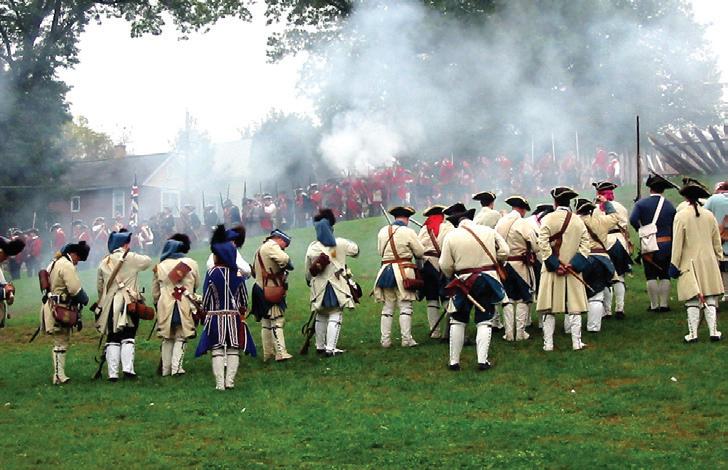

BY DIANA BOCCO
Argentina is a land definded by wild beauty.
From the towering Andes mountains to the windswept plains of Patagonia and the glacier-filled landscapes of Tierra del Fuego, Argentina’s landscape is full of dramatic vistas.
The country has long attracted explorers, starting with the arrival of Spanish settlers in the 1500s. By the early 20th century, waves of Italian, German and
other European immigrants completely transformed the country. Their influence is seen in Argentina’s European-style architecture, especially in the grand avenues and plazas of Buenos Aires.
Today, Argentina is a cultural melting pot, where Old World elegance blends with fresh cultural energy. Whether it’s the soulful rhythms of tango or the shared camaraderie over a yerba maté, groups will find plenty to enjoy.

Groups visiting Argentina will find a modern, vibrant capital city in Buenos Aires.
Affectionally known as the “End of the World,” Ushuaia is the southernmost city on Earth and the gateway to Antarctica. This Patagonian gem is set against the dramatic backdrop of the Martial Mountains and is known for its mix of rugged wilderness and modern comforts. Groups can visit Tierra del Fuego National Park, navigate the Beagle Channel or take a boat to see penguin colonies. Adventurers can also ride the End of the World Train through breathtaking landscapes, hike primitive trails or hop over to Antarctica for the ultimate oncein-a-lifetime adventure.
Argentina’s capital is a chic blend of Old World charm and modern energy with its colonial architecture, world-class museums and colorful street art. Often called the birthplace of tango, Buenos Aires’ streets pulse with music and dance, especially in the colorful La Boca neighborhood. Groups can see a performance at Teatro Colón, one of the finest opera houses in the world; stop by the famous Café Tortoni for a taste of history and coffee culture; or stroll through the historic Recoleta Cemetery, where the country’s most famous citizens rest. Those seeking nightlife might head to a milonga for tango dancing well past midnight.
A natural wonder, the Iguazu Falls comprise more than 250 waterfalls cascading over jungle cliffs for almost two miles along the border of Argentina and Brazil. It’s a jaw-dropping display of nature’s power and beauty. The surrounding national park is a UNESCO World Heritage Site and home to jaguars, toucans, monkeys and other creatures. Adventurous travelers can hike or take boat tours that bring them close to the thunderous falls. For a different experience, groups can cross into Brazil and walk the footbridge to the Devil’s Throat for an upclose view of the falls’ most powerful section.

A wine tour through the vineyards of Mendoza gives groups the chance to sample award-winning vintages, enjoy gourmet food pairings, tour winemaking facilities and bike through the vineyards where Argentina’s famous Malbec grapes grow under the shadow of Aconcagua, the highest peak in the Americas. Spread at the foot of the Andes, these vineyards produce some of the world’s finest wines.

Asado, Argentina’s take on barbecue, features meats slow-cooked over an open flame and served with chimichurri sauce, a flavorful blend of herbs, garlic and olive oil. For an authentic experience, head to a rancho in Patagonia, where gauchos (cowboys) prepare asado using traditional techniques.

The province of Jujuy, in northern Argentina, is home to the stunning Quebrada de Humahuaca, a narrow mountain valley known for its surreal, multi-colored hills. Often missed by tourists, this area is rich in history and natural beauty, where travelers can experience ancient Inca trails and small villages of Argentina’s indigenous people. Shopping at local markets filled with traditional artisan craftwork, colorful textiles and handcrafted goods is an option
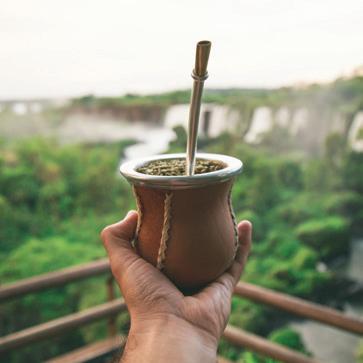
Handmade maté gourds and bombillas (metal straws) are popular Argentinian souvenirs. Used to drink yerba maté, a traditional South American tea, these intricately decorated gourds are an essential part of Argentina’s social culture. Often made from natural calabash gourds and adorned with silver, they make a beautiful and authentic keepsake.
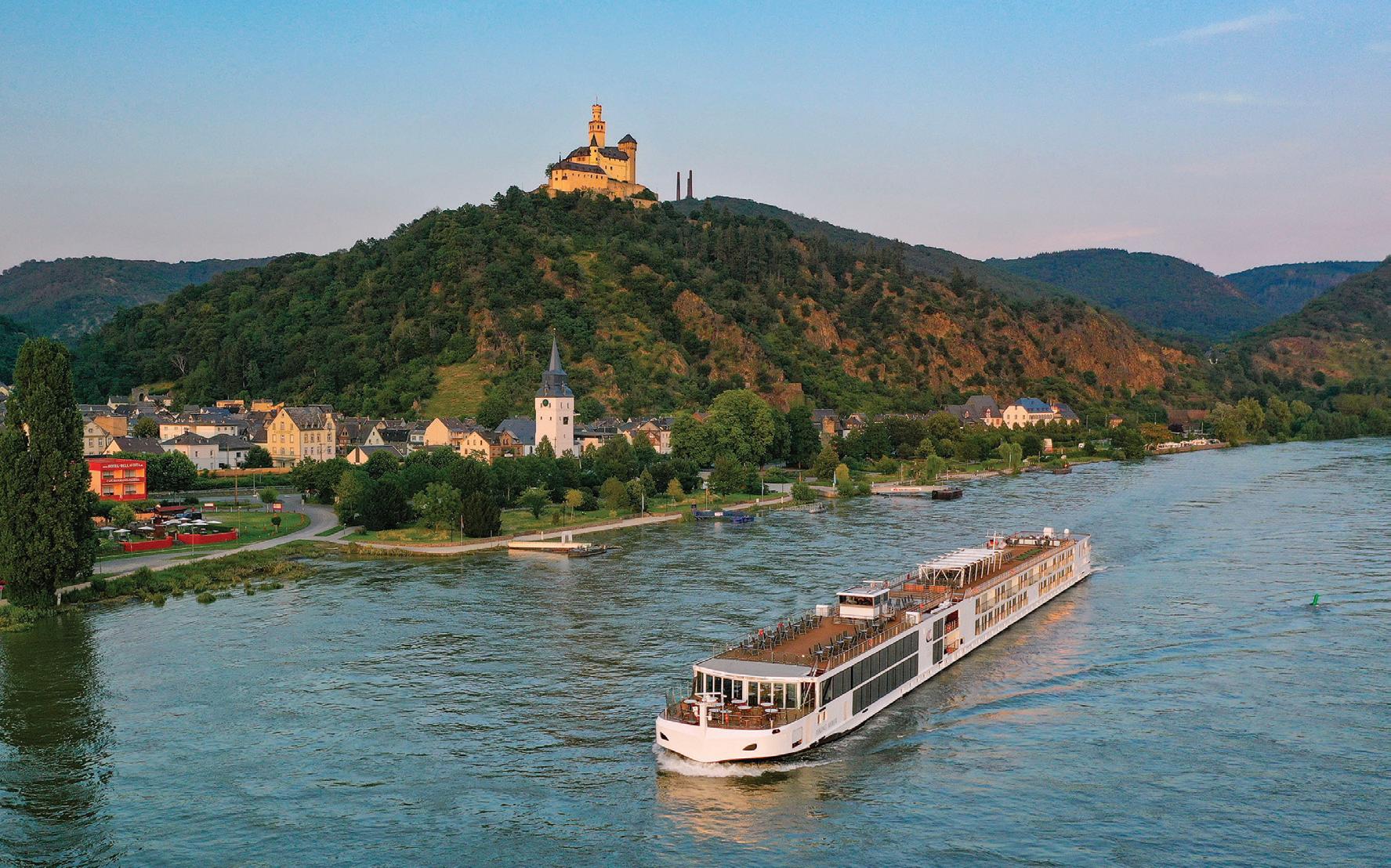
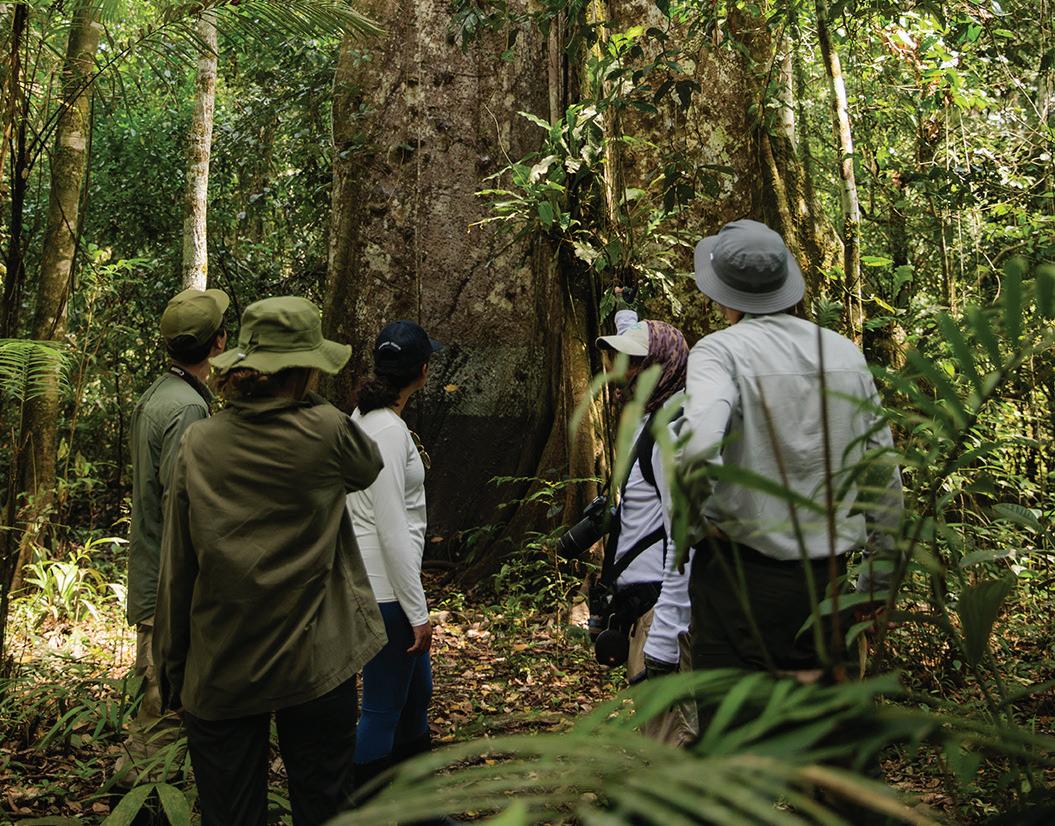

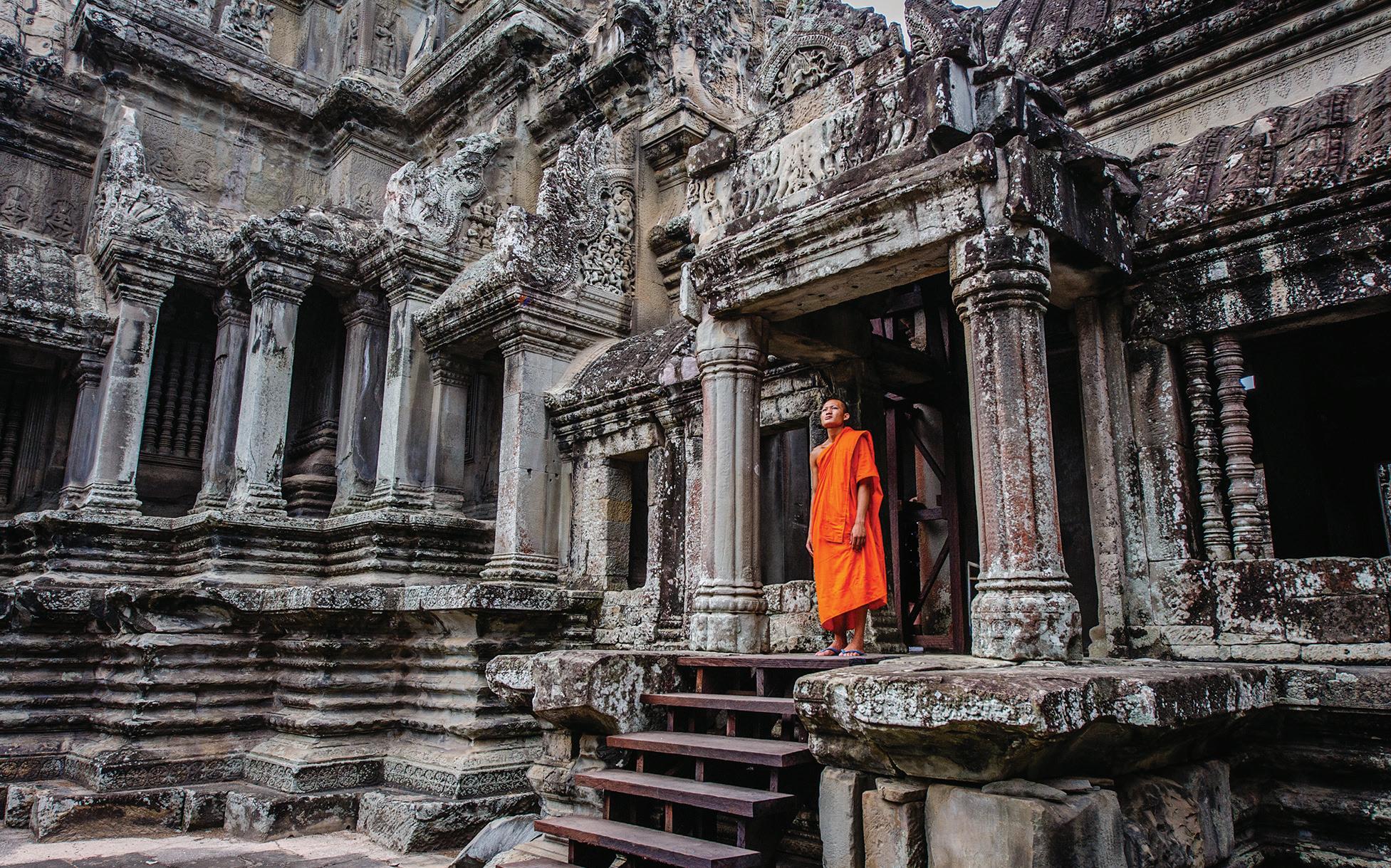
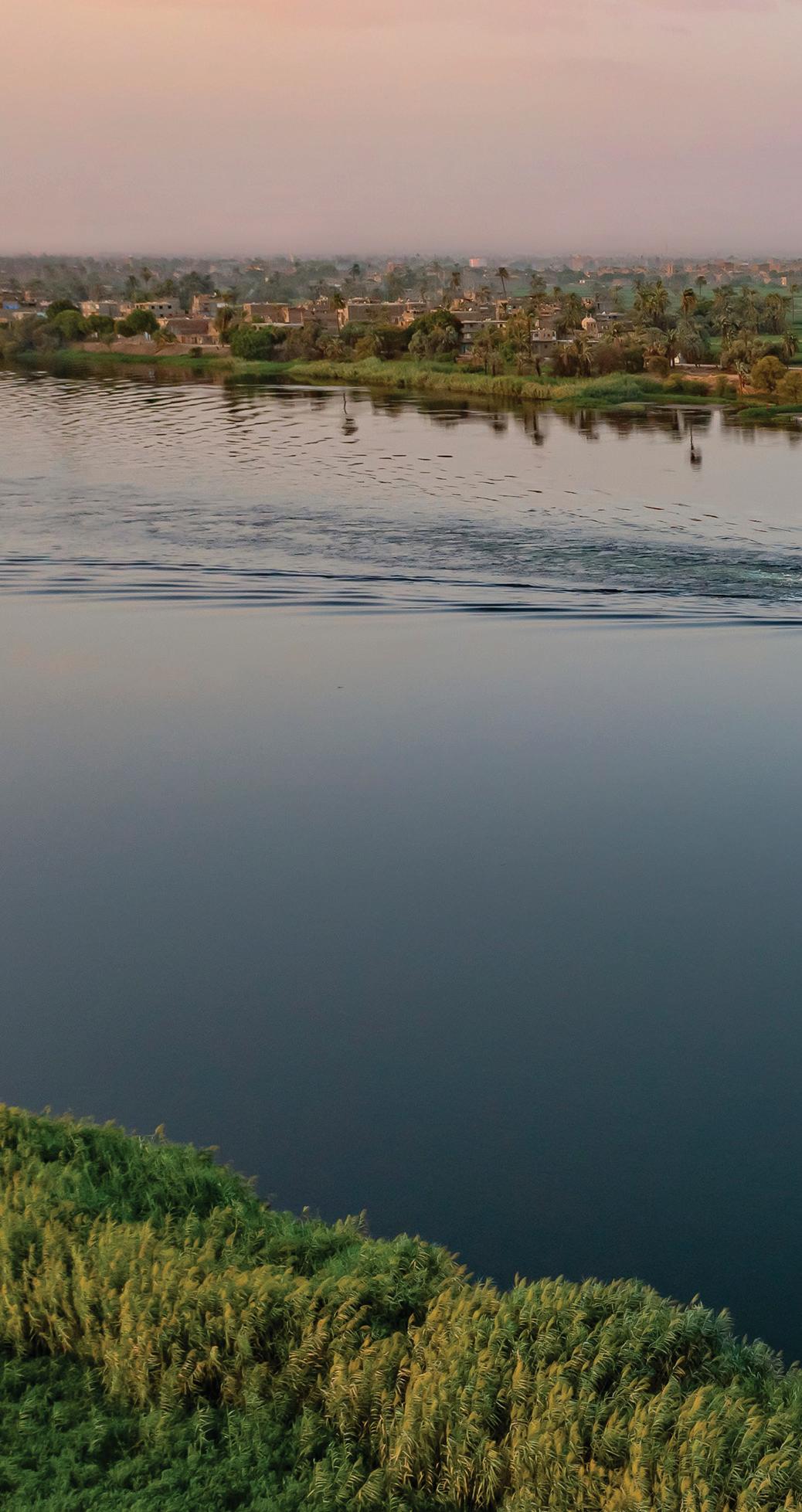


The world’s waterways have long acted as lifelines to human civilization, as our grandest rivers have advanced agriculture, trade and ultimately, great empires. That’s why today’s river cruises are among the best ways to travel. These small vessels, with their luxurious suites and intimate feel, allow travelers to explore important world heritage sites, untouched ecosystems and astounding architecture as they glide down rivers that often pass through several countries.
It’s a pleasurable way to check off travel bucket list items left and right. Here are some of the best routes to take along five continents’ most notable waterways.
The Nile is one of the most famous rivers in the world, thanks to its importance to ancient Egypt. The fertile soil along the Nile’s banks and the convenience of its pathway for trade allowed Egypt to become a powerful empire that lasted more than 3,000 years. Cruising it today lets visitors explore a fascinating civilization and its ancient wonders. Cruises typically begin in Cairo and include options for pre- and post-cruise stays in the city. Adding a stay in Cairo is a must for travelers, as they’ll spent up to three days seeing some of Egypt’s most iconic attractions like the Great Pyramids of Giza and the Sphinx; Old Cairo, home to one of world’s the largest concentrations of Islamic architecture; and the Egyptian Museum, with its 120,000-plus artifacts, including Hatshepsut and other royal mummies. After their stay in Cairo, travelers take a short flight to Luxor, some 300 miles down the Nile, to board their river vessel.
In Luxor, they can see the Karnak complex, the giant pillars of the Temple of Amun Ra and the Luxor Temple. Then, they’ll glide along the Nile to the city of Edfu to see the Valley of the Kings and the Valley of the Queens, where 63 royal burials have been discovered. From there, the cruise stops in Kom Ombo and Aswan for more tours of ancient temples and lectures by Egyptologists. The cruise then returns to Luxor and passengers fly back to Cairo. Popular packages are offered by Avalon Waterways, Viking Cruises and AmaWaterways. Egyptian cruise lines also offer packages.
Winding approximately 4,345 miles through South America, the Amazon River is either the longest or second-longest river in the world — its competition for this title is the Nile. Although the river’s headwaters are in Peru’s Andes Mountains, most of the Amazon is in Brazil, where it flows through the world’s largest rainforest. Cruise itineraries typically focus on Brazil or Peru, and both are rewarding experiences. Voyages on the Peruvian Amazon offer a glimpse of remote beauty, including an impressive array of wildlife and indigenous tribes.
Itineraries for the Peruvian Amazon typically begin and end in Iquitos. As the ship glides south, travelers can enjoy excursions into smaller rivers aboard skiffs and canoes, where they can watch sloths, colorful songbirds, spider monkeys, pink river dolphins and other wildlife. They’ll see the Pacaya Samiria National Reserve and visit the nearby town of Nauta and its local village markets and take guided hikes through the lush rainforests, where flora and fauna of extraordinary colors dazzle. Many of these cruises end with a stop at the Manatee Rescue Center near Iquitos.
Some of the most comprehensive Amazon packages include a pre-cruise trip to the Sacred Valley of the Incas with hiking to the breathtaking ruins of Machu Picchu, the 15th-century Incan citadel and Peru’s biggest tourist

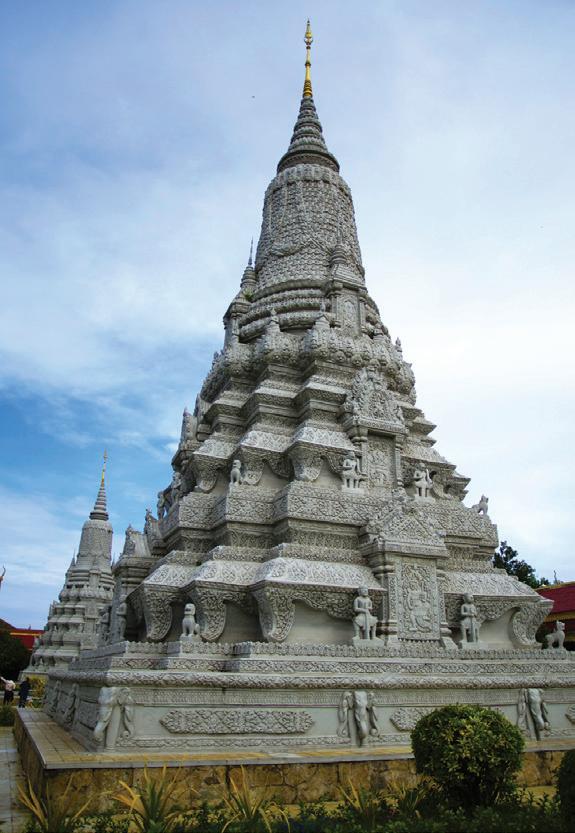
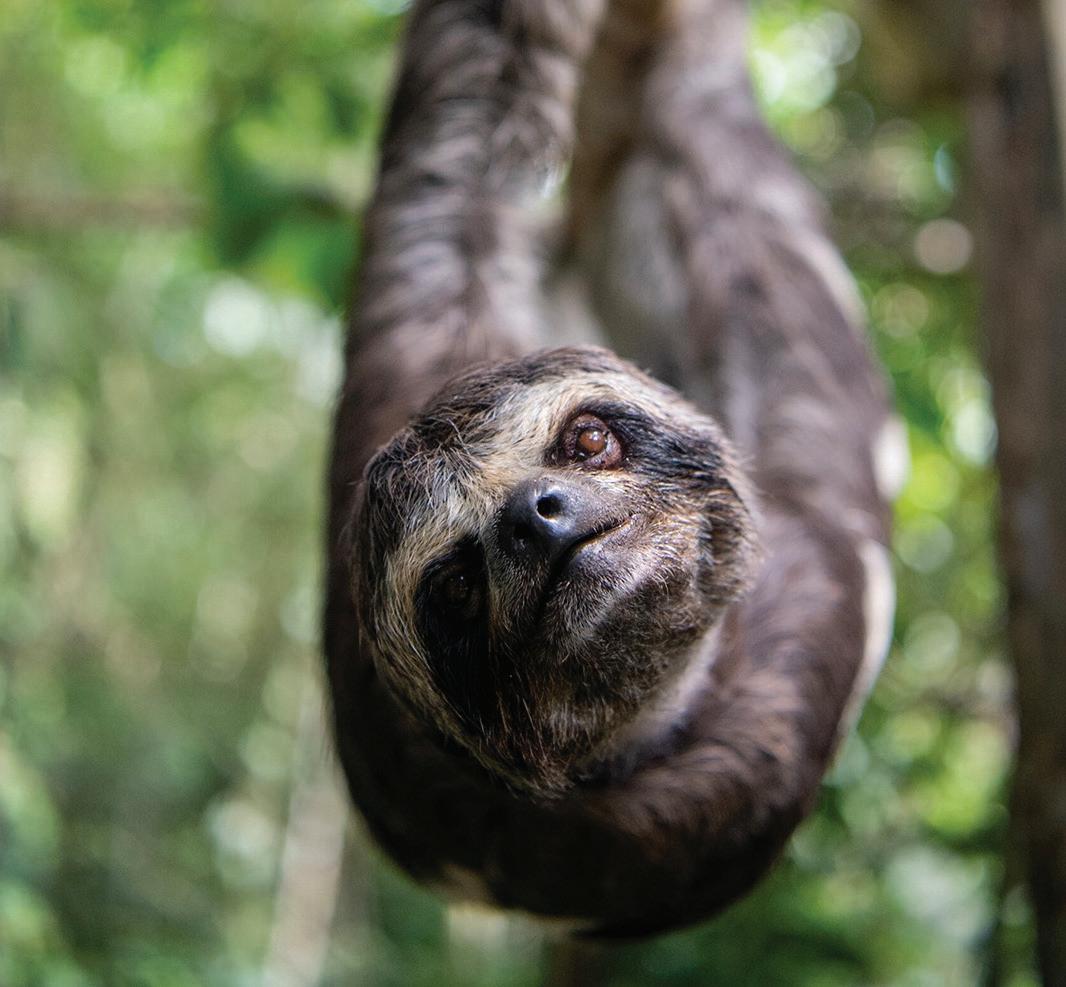
attraction. Passengers fly into Lima and then Cusco before traveling to Iquitos by train. Popular vendors for Peruvian Amazon River cruises are Aqua Expeditions, Rainforest Cruises and Delfin Amazon Cruises.
Europe’s many waterways are bordered by old cities and bustling tourist stops, which can make it hard to choose one route to explore. European cruises can be a great way to see multiple countries in a short period of time, and seasonal events and attractions add even more interest. One of the most popular routes and an excellent starting point for cruises in Europe is the Rhine River, which begins in the Swiss Alps and flows north along the border of Germany and France and through Germany before it drains in the Netherlands.
Cruises along the Rhine either begin in Basel, Switzerland, or in Amsterdam, the capital of the Netherlands. Pre- and post-cruise add-ons allow passengers to spend time in either of these Old World cities. Passengers embarking in Basel will see where Germany, Switzerland and France meet; view stunningly intricate and historic architecture; and visit some of the city’s more than 40 arts and cultural museums.
The cruise makes several stops in Germany and France, including Breisach, with excursions to the Black Forest; Strasbourg, home to Renaissance architecture and one of Europe’s most impressive Gothic cathedrals; and Cologne, home to another notable Gothic cathedral and a lively beer scene. As they travel down the river, passengers will

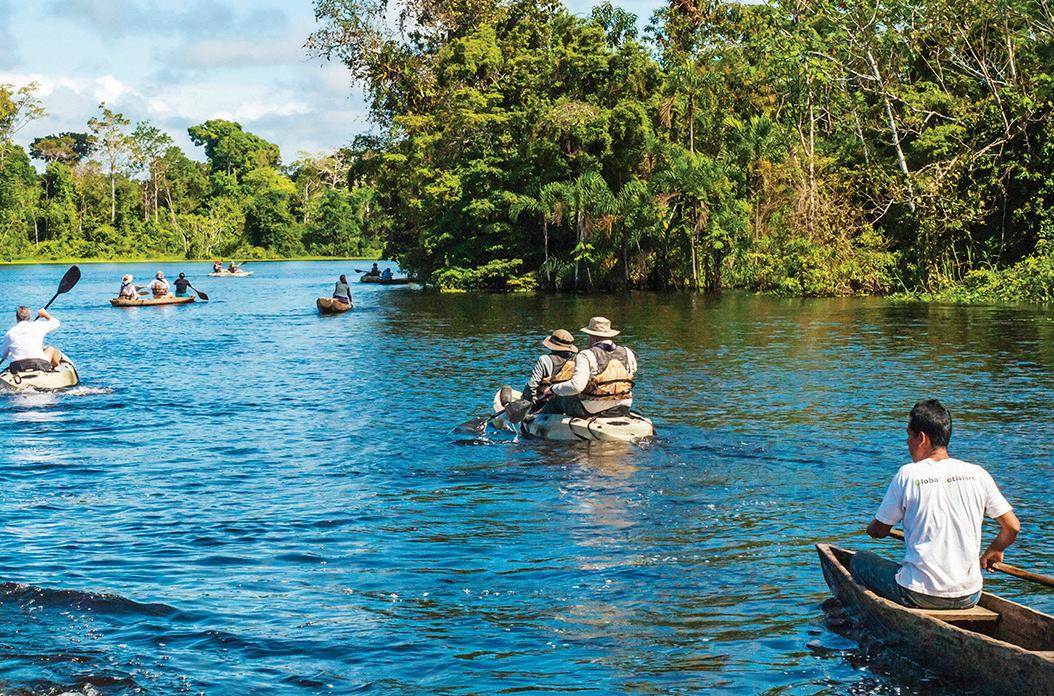
on popular trails and sites like Multnomah Falls in the Columbia River Gorge, one of the largest national scenic areas in the country.
In Washington, a stop in Walla Walla can include historic monuments, charming local shops, Palouse Falls and Hells Canyon, the deepest river gorge on the continent. Passengers disembark in Clarkston and can then fly from nearby Lewiston, Idaho, or Spokane, Washington.
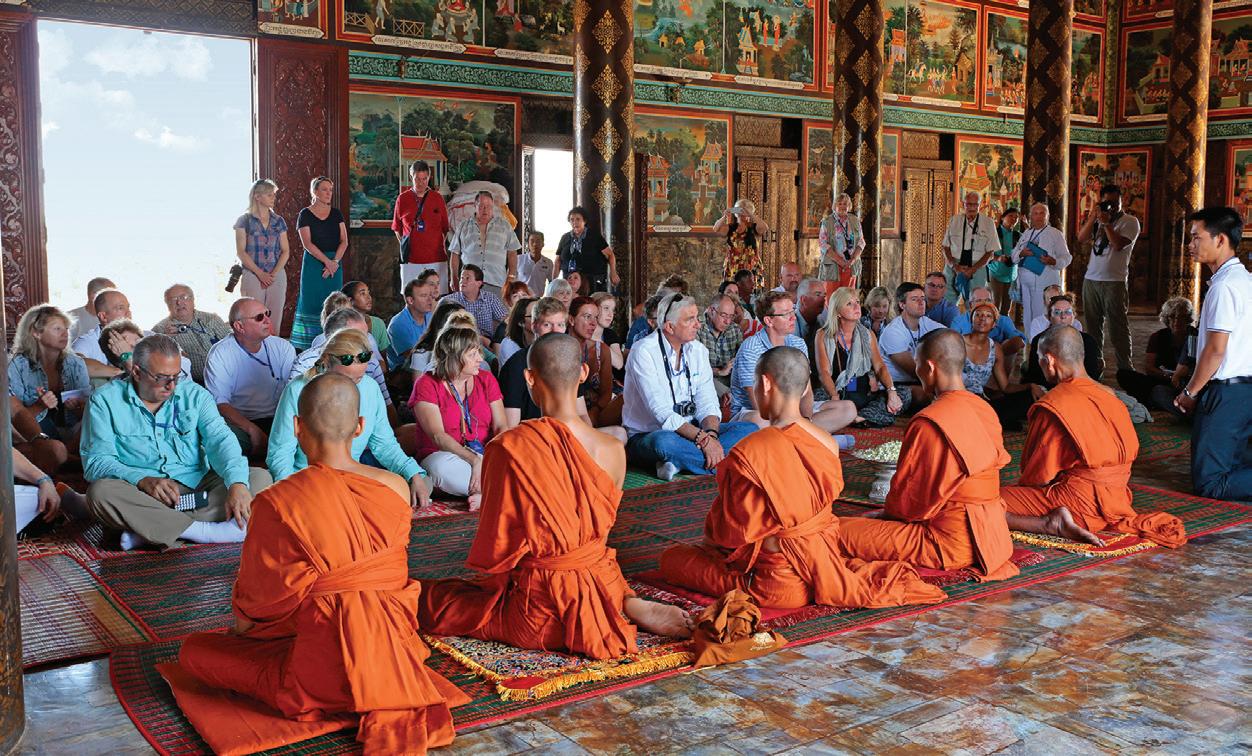
Meeting monks at Cambodia’s Oudong Temple
see the verdant countryside’s vineyards and many medieval castles on the Middle Rhine, a UNESCO World Heritage Site. Tours end in the Netherlands, with visits to the village community of Kinderdijk, with its old-fashioned Dutch windmills from the 18th century, and Amsterdam, known for its picturesque canals and museums.
Viking Cruises, Avalon Waterways, AmaWaterways and Uniworld offer Rhine cruise itineraries from 7 to 11 days.
While the best-known river cruises in North America are along the Mississippi River, there’s another route that’s gaining popularity thanks to the Pacific Northwest’s breathtaking scenery. A river cruise package along the Columbia and Snake rivers focuses on the region’s natural beauty, Lewis and Clark Expedition history, and wine and cuisine. Cruises typically begin or end in Portland, Oregon, with optional pre- or post-cruise add-ons to explore the city. Some cruises include sailing under 12 electric bridges on the Willamette River in Portland. Astoria, where Meriwether Lewis first glimpsed the Pacific Ocean, is at the river’s mouth; here, travelers can stop at the maritime museum and visit shops and restaurants. Then, the river takes groups east, for excursions that include hiking
Throughout the cruise, there are stops at local wineries, storytelling about the American West from historians and fine local food onboard. Major cruise companies include Lindblad Expeditions (in partnership with National Geographic) and American Cruise Lines. Voyages typically run from April to November.
From its starting point in the Tibetan Plateau to the South China Sea, the Mekong River stretches more than 3,000 miles and passes through China, Myanmar, Laos, Thailand, Cambodia and Vietnam. The river has different names in different countries, but no matter what it’s called, one thing remains true across borders: this massive river and its floodplains are essential to the communities and the natural world that surrounds it.
Mekong cruises typically explore the stretch of the river that runs through Vietnam and Cambodia. Ho Chi Minh City in Vietnam, commonly referred to as Saigon, is a popular departure point with its mix of colonial buildings, traditional temples with pagodas and skyscrapers. A historic walking tour gives passengers time to shop and take in the blended French and Asian cultures. Some longer cruises, such as those offered by Viking, keep travelers in the city for three days before departing for other Vietnamese or Cambodian cities.
While excursions to small towns and villages vary, another city that’s almost always on a Mekong River itinerary is Phnom Penh, the capital of Cambodia. Here, travelers can tour the Royal Palace and Silver Pagoda, as well as the Wat Phnom Daun Penh, a Buddhist temple. Excursions to a silversmith village and a monastery are often offered. Another Cambodian city on many itineraries is Siem Reap, home to UNESCO World Heritage Site Angkor Wat, the best preserved and most significant Angkor temple.
On some itineraries, passengers disembark at Siem Reap to fly home, but others include a post-cruise adventure in the city or a return flight to Hanoi, Vietnam. Tours range from four to 15 days, and popular vendors include Viking, Avalon Waterways, Aqua Expeditions and Mekong River Cruises.

WITH ASHLEY RUNYON
Are you taking advantage of digital communications to grow your travel program?
In our increasingly connected world, the technology you use at work can be leveraged to streamline and improve travel operations. Webinars and video conferencing can be useful tools for affinity travel planners.

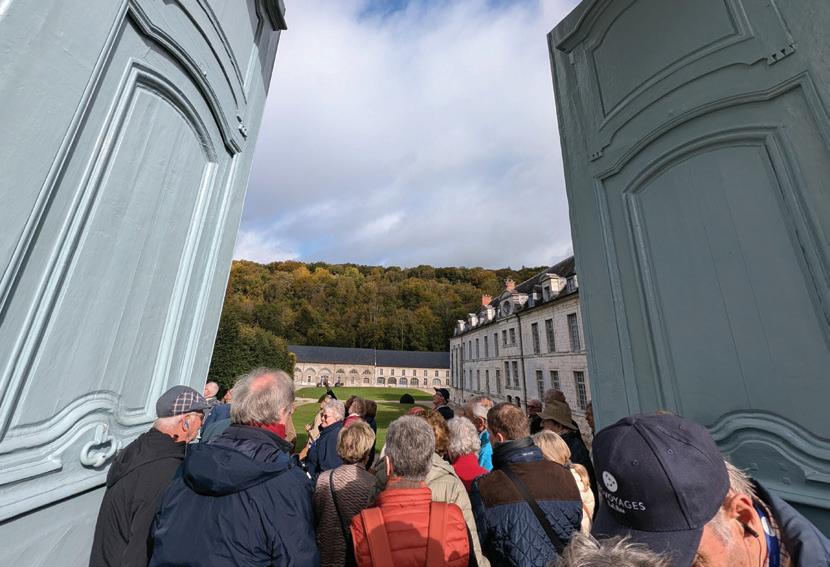
Ashley Runyon (left) uses video conferencing events to market tours and share pre-departure information with her travelers.
Most of us have attended a webinar at some point, but have you ever hosted one to communicate with your travelers? In much the same way you use video conferencing to meet with colleagues, communicate with vendors or learn about potential travel destinations, you can also use it with your travelers. Some of your members are less tech savvy than others, but they they likely all use some form of digital communication, so hosting travel webinars can be a great way for them to engage with you from the comfort of their homes. This can strengthen your relationship with them, helping you grow your travel program and advance your organization’s mission.
Here are some ideas about how to make webinars and video conferencing work for your travel club.
The possibilities are vast for using webinars. They can generate excitement for upcoming tour announcements, spotlight specific trip opportunities, hold know-before-you-go meetings, share post-tour videos and photos, solicit feedback and share upcoming changes. I especially appreciate webinars that help generate buzz and excitement about upcoming tours. Try using webinars to tell potential travelers about a new trip that you’re offering for the first time. This will entice people to join the webinars and, hopefully, book trips.
Many travel clubs have a know-before-you-go meeting for each tour, but it can be a challenge to find a time that works for everyone to meet in person. Making the meeting a webinar can solve that problem. It’s a great way to make sure everyone receives details about the trip, what to pack, and departure and return information. If you record the webinar, a replay link can be sent to group members who couldn’t attend it live. There’s also a lot of room for creativity, which can help build excitement for the upcoming trip.
Having a webinar allows you to invite guests to speak to your group without them making the trip to your physical location. To make sure this works out well, meet with the guest speaker ahead of time to plan the event. Discuss what the guest will talk about and the messages you want them to convey.
If your guest speaker is a vendor who is helping you promote a tour, decide whether they need to introduce and build trust with their company, market the trip, or help you build trust with your travelers. Whatever your objective, make sure your guest speaker is onboard. Without direction, your guest speaker could make comments you are un-
Ashley Runyon is a longtime bank and travel club planner. She lives in Ashland, Kentucky, with her family of six.
comfortable with. Reviewing an agenda together before the webinar can help avoid this.
Let’s face it — webinars can be boring. To make sure people look forward to yours, find ways to make them more appealing. Giveaways or discounts on travel for those who join the webinar can add excitement, but make sure only those in attendance get the reward.
Choose your giveaway in advance and use it as an incentive when you market your webinar. And when you introduce your travelers to webinars, offer as many benefits as possible to entice them to join. Some members who have been traveling with you for a long time may be slow to embrace change,
so use your creativity to come up with perks that will motivate them to try something new.
Did you know that most video conferencing tools allow you to screenshare? This feature comes in handy during one-on-one meetings with clients, especially those who may need help with digital registration. If your travel club takes cruises or travels internationally, vendors frequently ask participants to submit some information in digital formats. This could include creating a website account or filling out a visa application online. If someone is having trouble, you can use screen-sharing to walk them through the process.
Using video conferencing to communicate with your travelers increases the number of touchpoints you have with them. The more you interact with your travelers, the more they will trust you. That trust is a key component of your relationship with members, so create as many interactions as possible to reinforce it.
There are endless ways to use webinars and video conferencing to help build your business or connect with your travelers. Get creative and explore how technology can give you more connections.
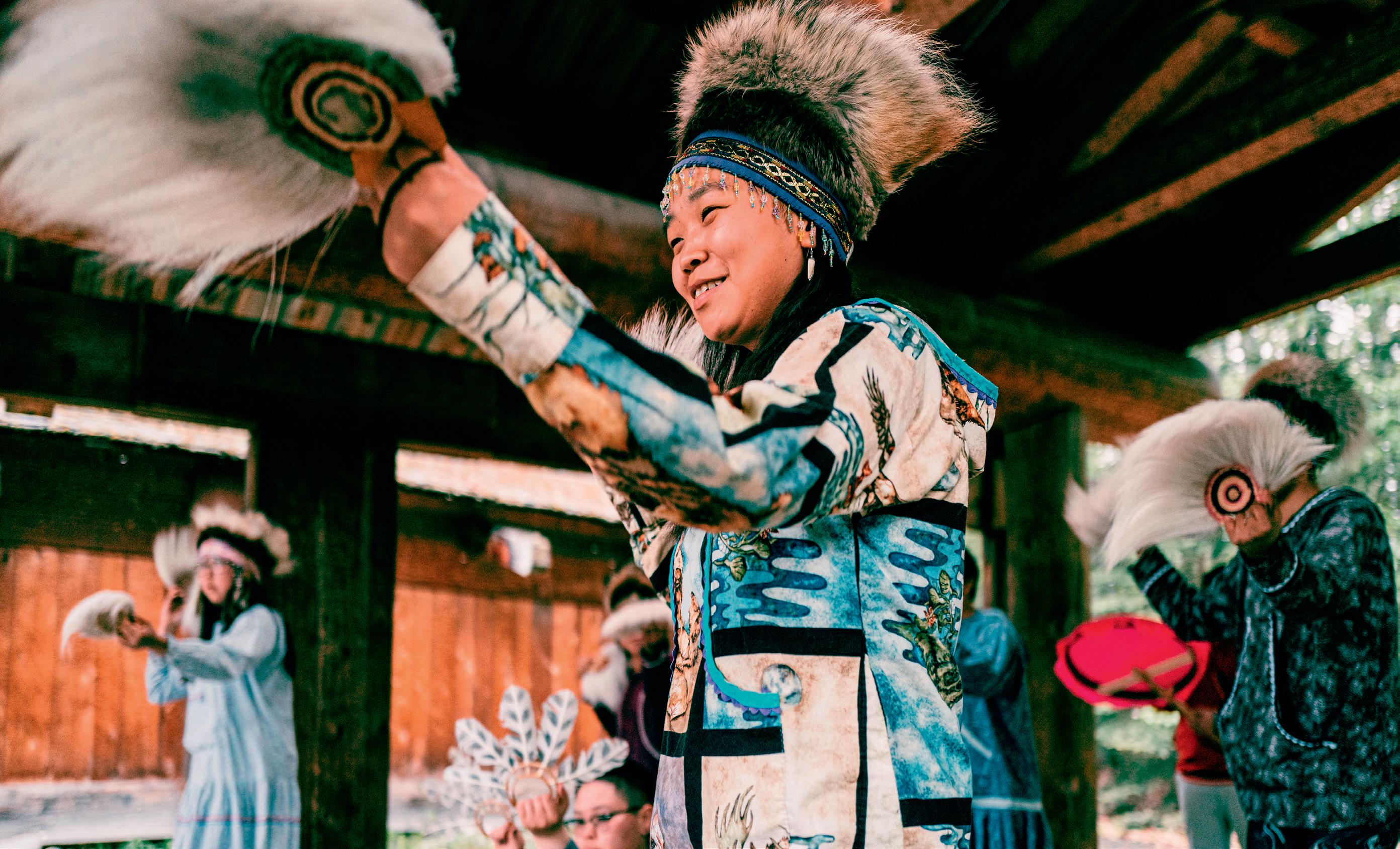

Travelers want rich, authentic, and meaningful experiences. As travel professionals, we need to ensure we use travel as a force for good.
hands-on cultural experiences, impact organizations, sustainable products and more through the Tourism Cares Meaningful Travel Map.



